LightWave History
All the versions of LightWave - so far
1988 - Precursor to LightWave 3D
Before LightWave came Videoscape 3D and Aegis Modeler 3D on the Commodore Amiga. Videoscape was written by Allen Hastings and Modeler 3D by Stuart Ferguson, giving a historical basis behind the split personality of LightWave 3D. Have a look at the sticker on the Videoscape 3D box to see how things have evolved since this program was state of the art...
Of course, the Videoscape solution wasn't the only one available to NewTek when they wanted to add a 3D graphics application to the Amiga Video Toaster back in 1989 - it was almost equipped with Dr. Eric "Juggler" Graham's Sculpt 3D...
- screens courtesy: Ernie Wright (Videoscape #3 and Modeler 3D) and Hector Moratilla (Videoscape #1 & #2)
- Videoscape box courtesy: Franck Lafage
- Modeler 3D box courtesy: Stuart Ferguson (the programmer) and Gökhan SÖNMEZ from AGF, Turkey
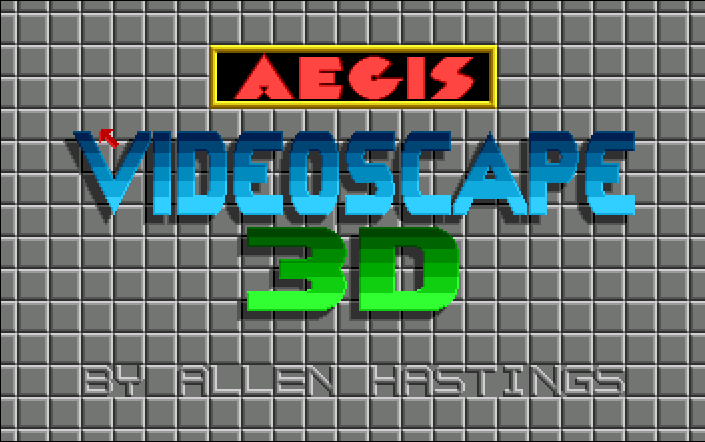
Videoscape Amiga
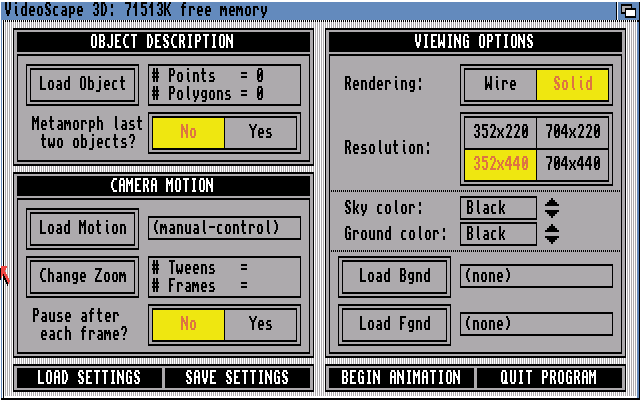
Videoscape Amiga
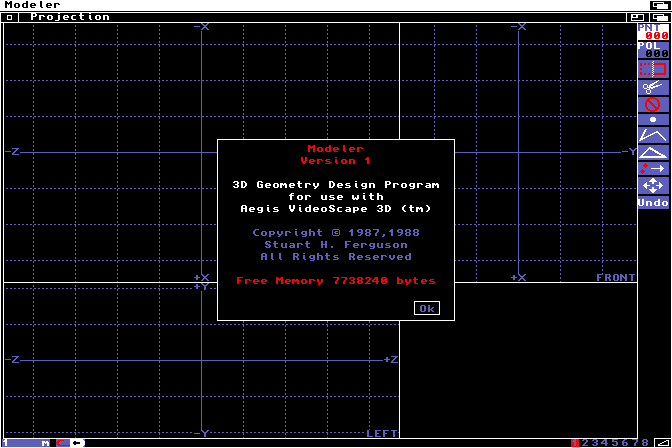
Modeler Amiga
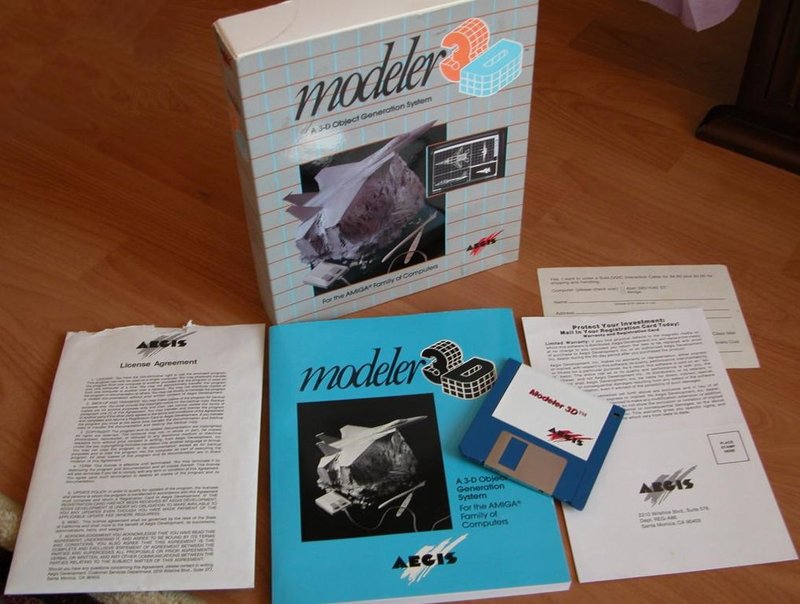
Modeler Boxshot
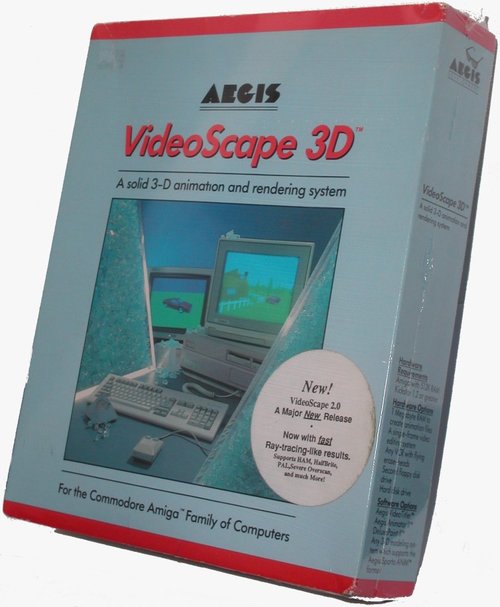
Videoscape Boxshot
1990 - LightWave 3D 1
1990 saw the first actual release of LightWave on the Commodore Amiga-based Video Toaster. NewTek had been promising its arrival for about two years at this point, but the problem lay with the chipset for the Video Toaster itself, not LightWave. At this point in time, there were 3D programs available, but they tended to cost tens of thousands of dollars, while the whole Toaster retailed for less than $5,000. The only real competition for 3D on the Amiga at that time came in the form of Imagine.
- screens courtesy: Ernie Wright
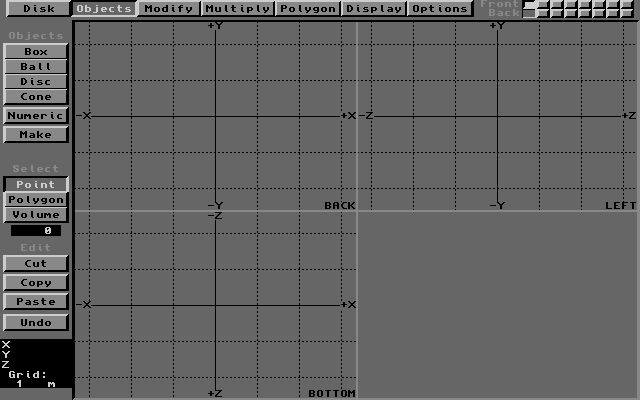
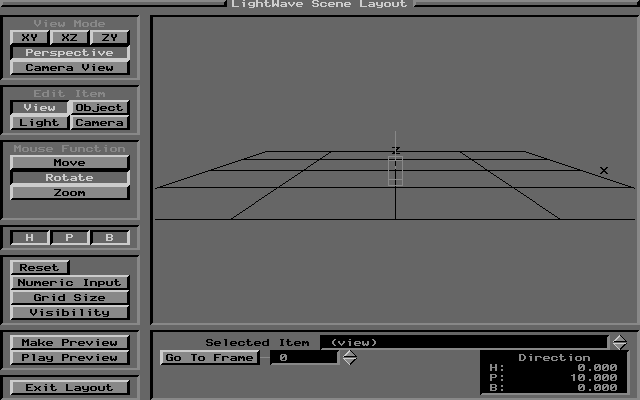
Modeler and Layout 1.0 Amiga
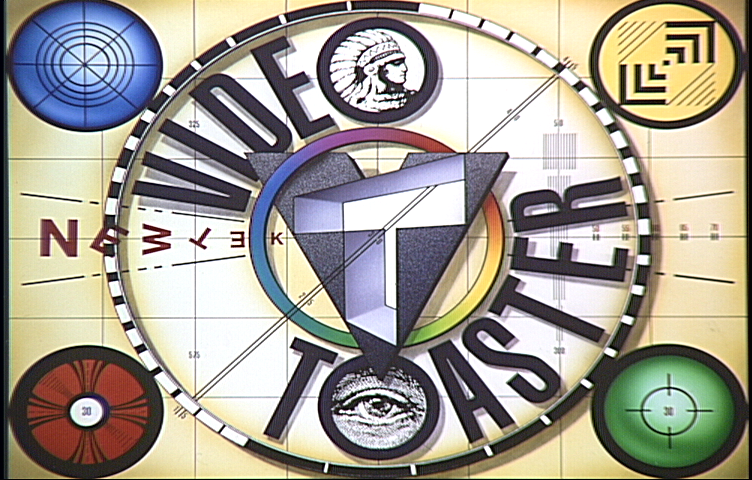
Video Toaster Logo
1992 - LightWave 3D 2
The Video Toaster got an upgrade in 1992 and so did LightWave. Later that year NewTek released the "LightWave 2.5 Pro" slice upgrade. This was the first version to have built in lens flares and some other "special" goodies for the Lightwaving Toaster users.
1993 - LightWave 3D 3
LightWave was still locked to the Video Toaster with the VT4000 that came out this year, however, a small company called Industrial Might and Logic catered to a growing number of people who wanted access to LightWave but didn't or couldn't use the Video Toaster (because they had Amiga 3000s or lived in countries that used a television system other than NTSC). IML (natch) created their own dongle (named "LightRAVE" often referred to simply as "RAVE") that emulated the presence of the Video Toaster card so that LightWave could be run on machines without the desktop video card.
- screens courtesy: Bernhard Bazant
- box shot courtesy: Norm Pickthall
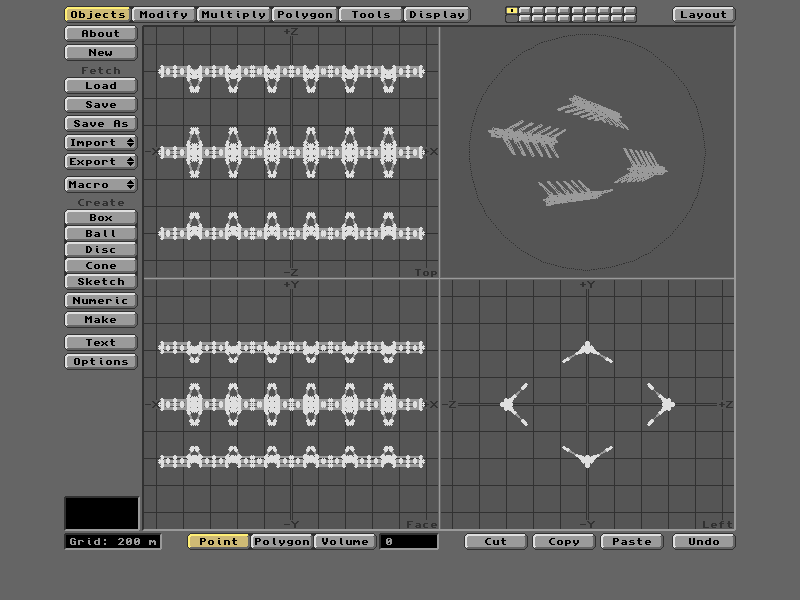
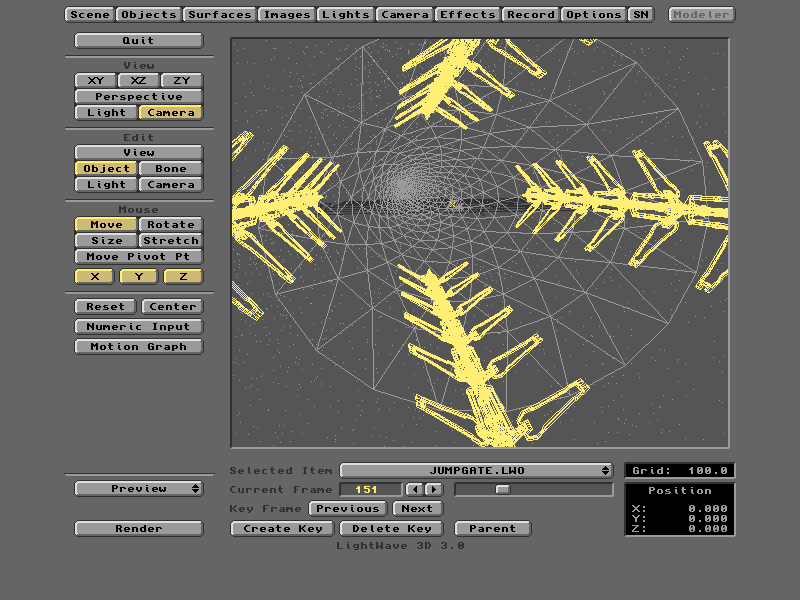
Modeler Amiga, Layout Amiga
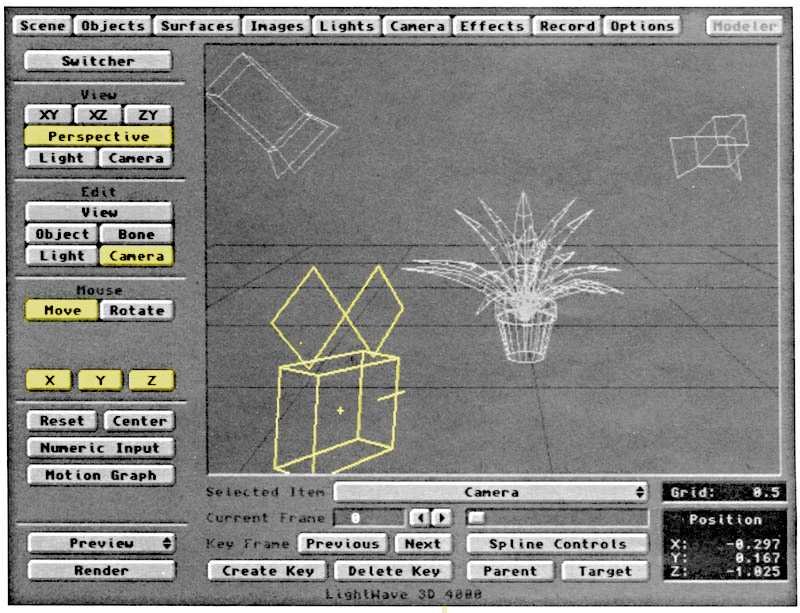
Layout LightWave 3D 4000 Amiga
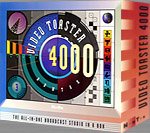
VT4000 Boxshot (lores!)
1994 - LightWave 3.5
1994 - LightWave 3D 3.5
The first official stand-alone version for the Amiga (no Video Toaster required)
- box courtesy: Gökhan SÖNMEZ
- screens courtesy: Bernhard Bazant
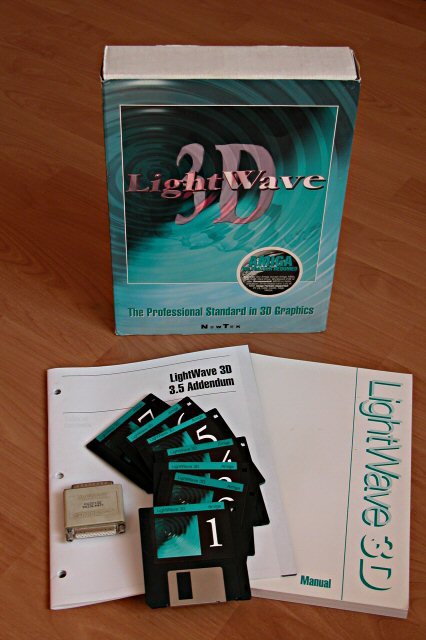
Packshot with Box detail
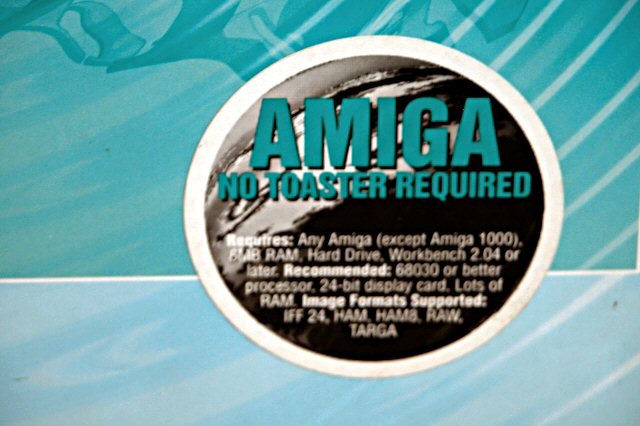
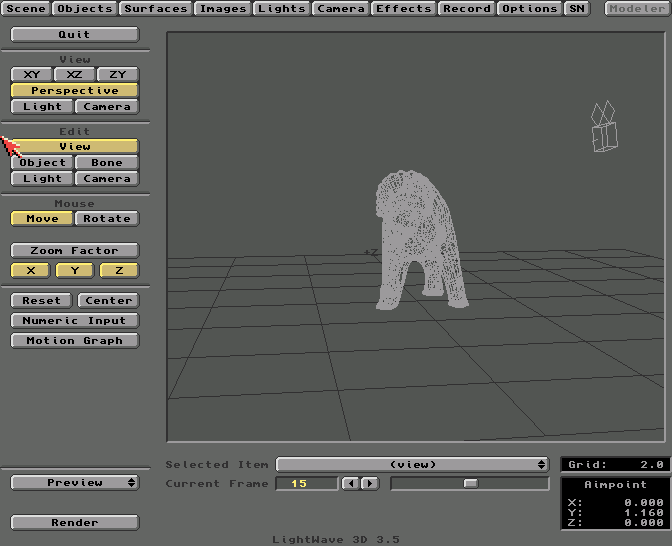
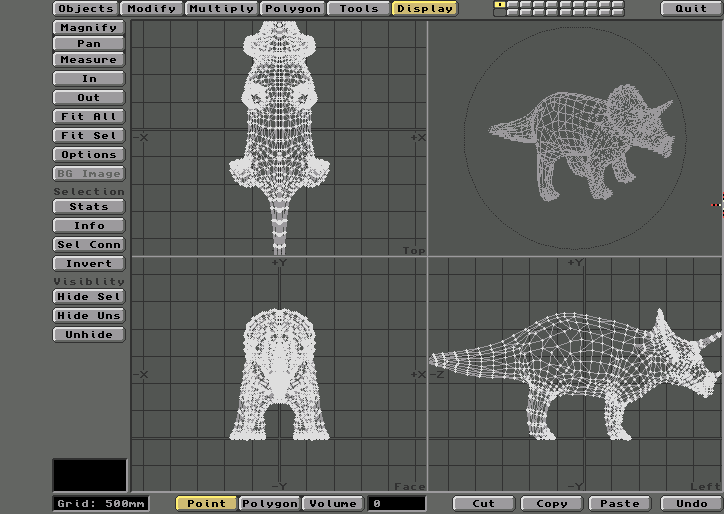
Layout and Modeler 3.5
1995 - LightWave 3D 4
This was the first version ported to Windows PCs and DEC Alphas.
- PC screens courtesy: Anthony Rosbottom
- Amiga screens courtesy: Bernhard Bazant
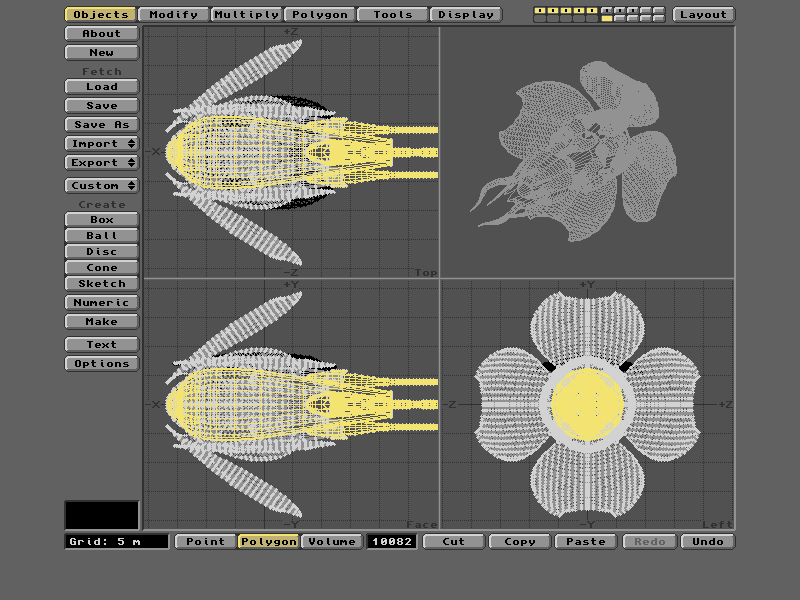
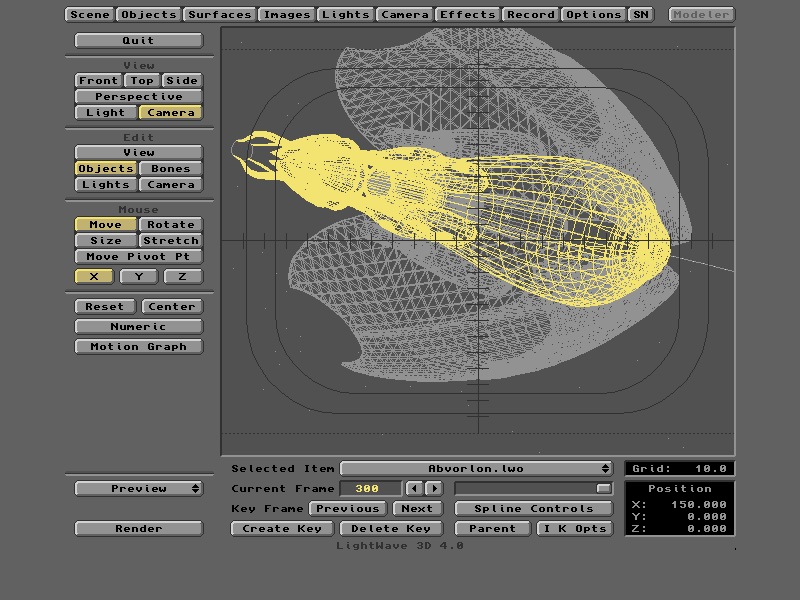
Modeler 4.0 Amiga version, Layout 4.0 Amiga version
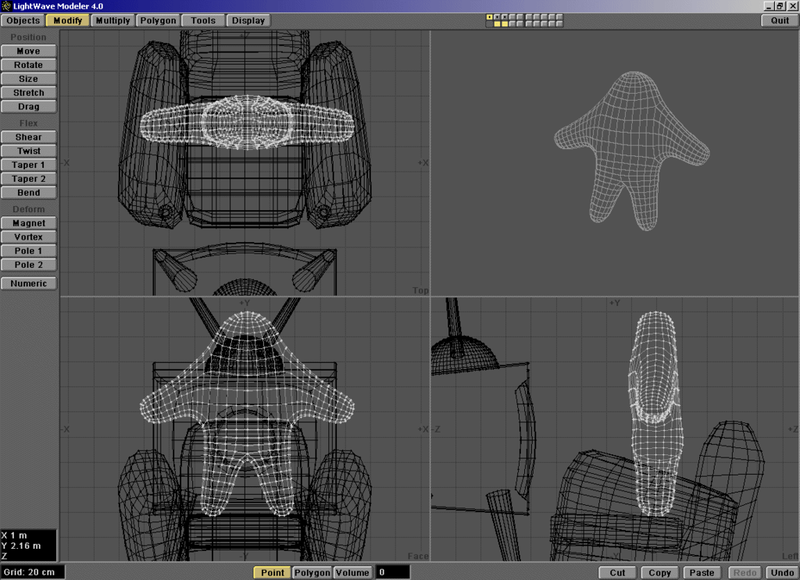
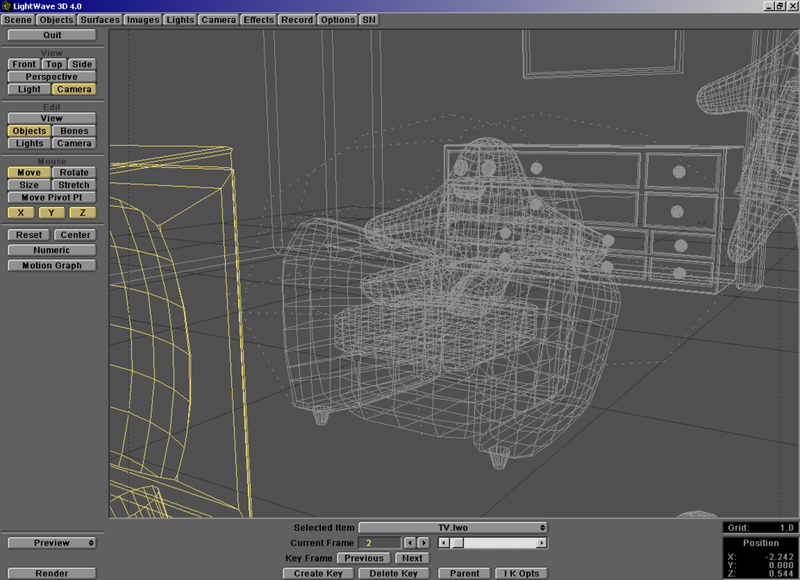
Modeler 4.0 Windows version , Layout 4.0 Windows version
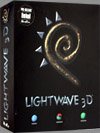
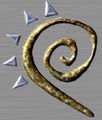
LightWave 4.0 Boxshot and Logo Windows (lores!)
1995 - LightWave 3D 5
This was when NewTek really started to branch out. LightWave was available for Intel and now also for SGI, DEC Alpha, Macintosh, and in its last version for Amiga
- PC screens courtesy: Norm Pickthall
- Amiga screens courtesy: Bernhard Bazant
- box courtesy: Norm Pickthall
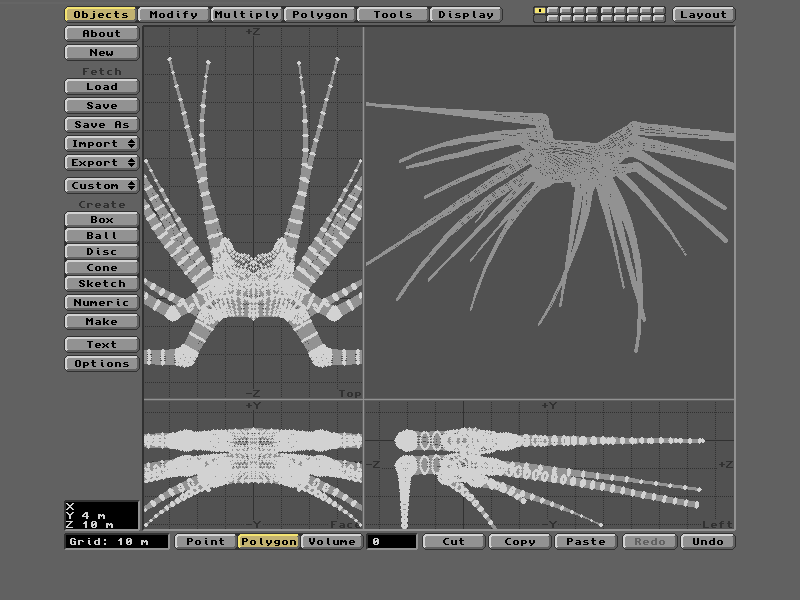
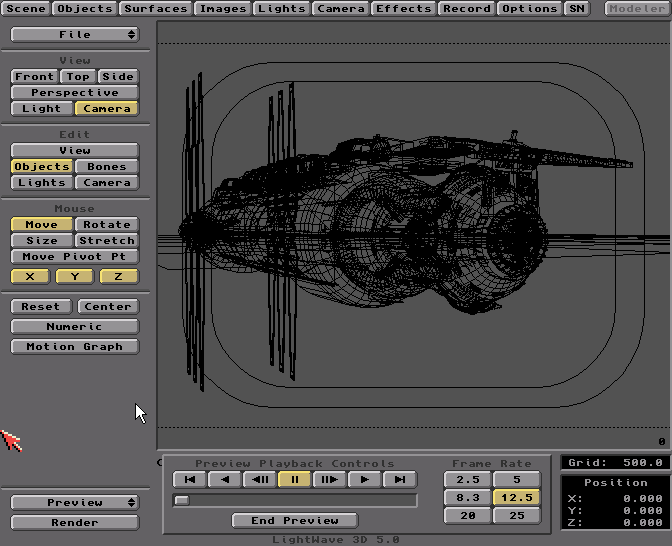
Modeler 5.0 Amiga version , Layout 5.0 Amiga version
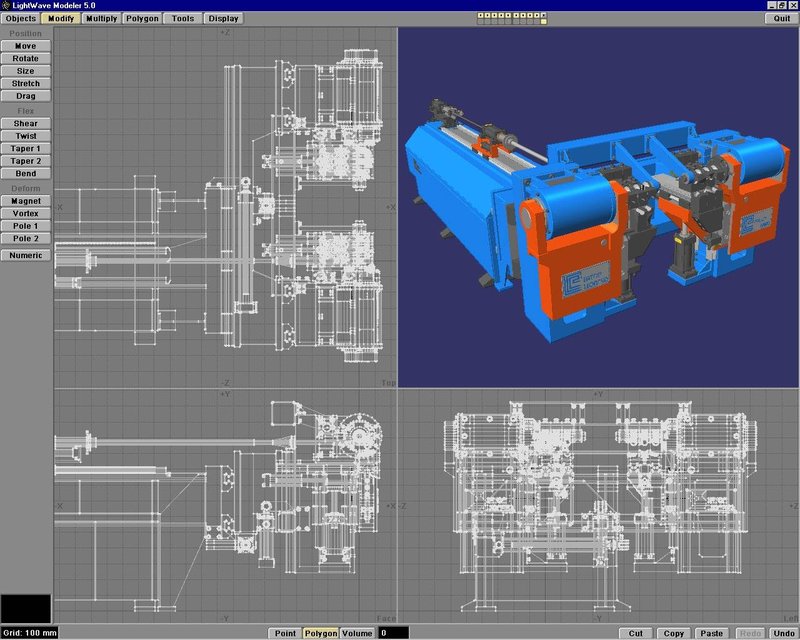
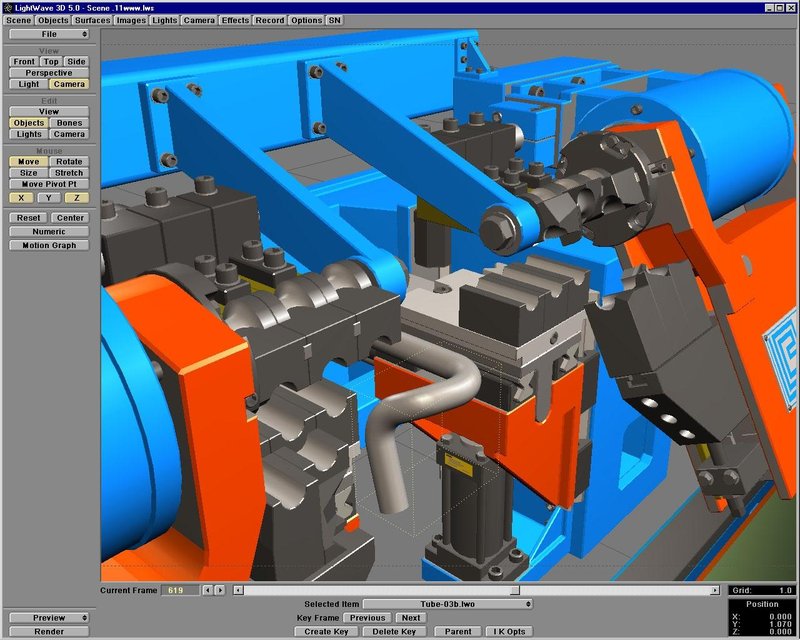
Modeler, Layout 5.0 Windows version

Boxshot and logo (lores!)
1997 - LightWave 3D for the VTNT
In 1997, NewTek brought out a version of the Video Toaster for the PC platform on a PCI card. It had to come with LightWave as had previous Amiga incarnations, so here is the Video Toaster bundled version.
- screens courtesy: unknown
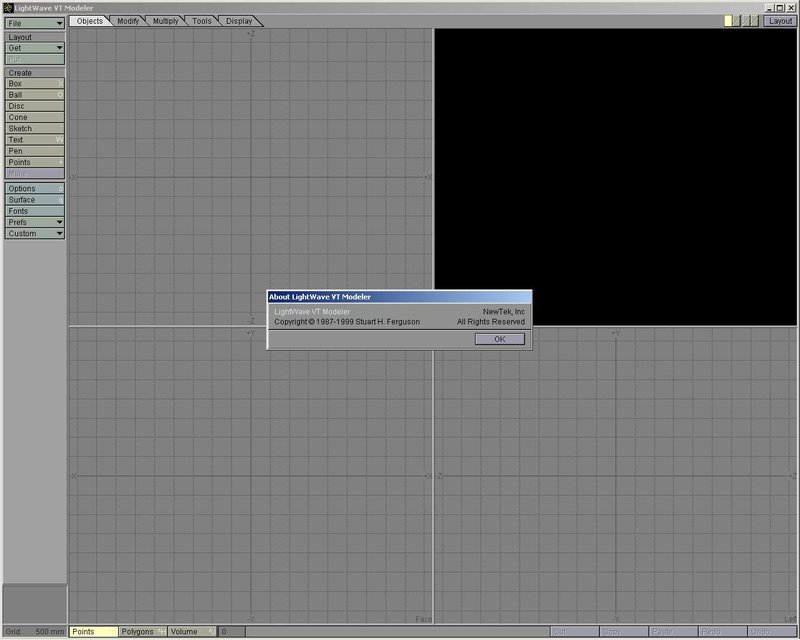
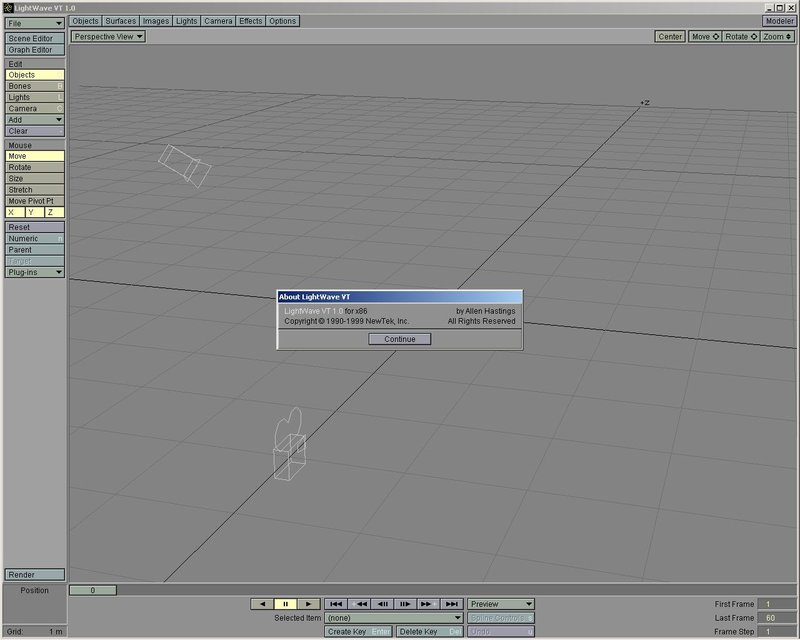
Windows Video Toaster version of Modeler and Layout
1997 - LightWave 3D 5.5
- screens courtesy: unknown
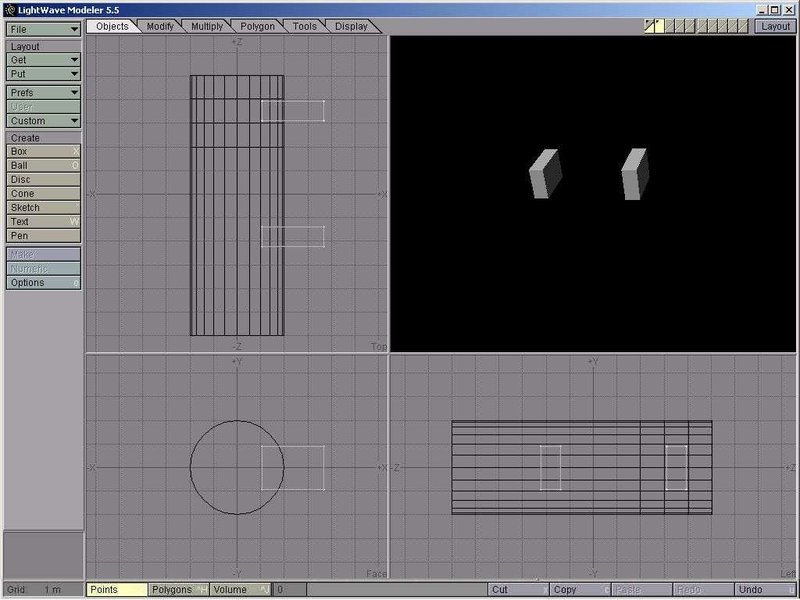
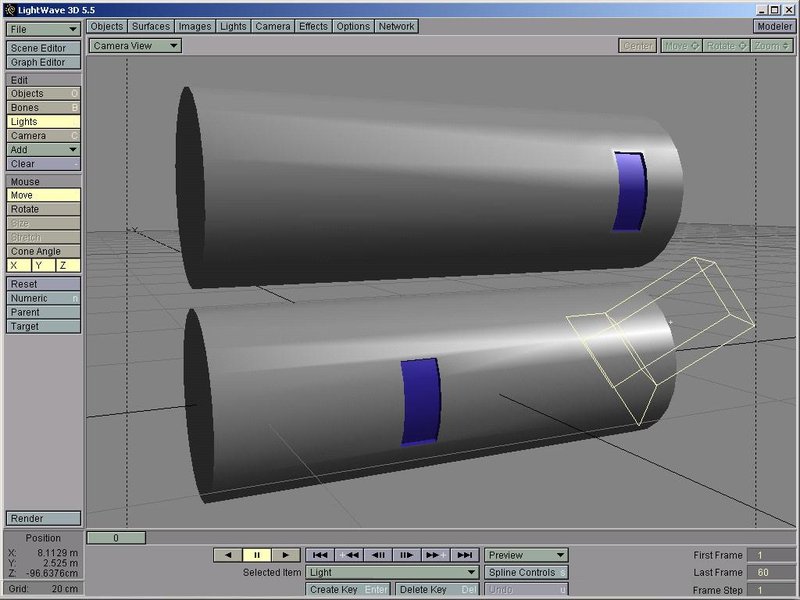
Modeler, Layout 5.5 Windows version
1998 - LightWave 3D 5.6
- screens courtesy: Deuce Bennett
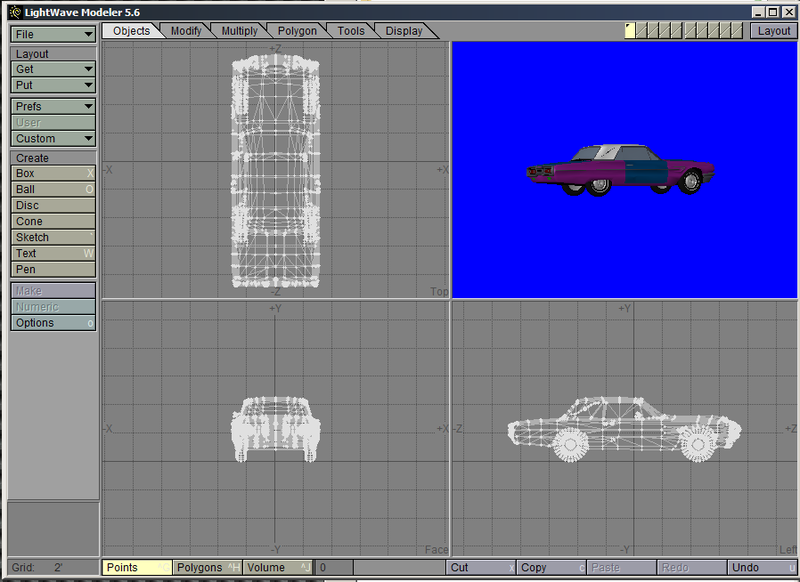
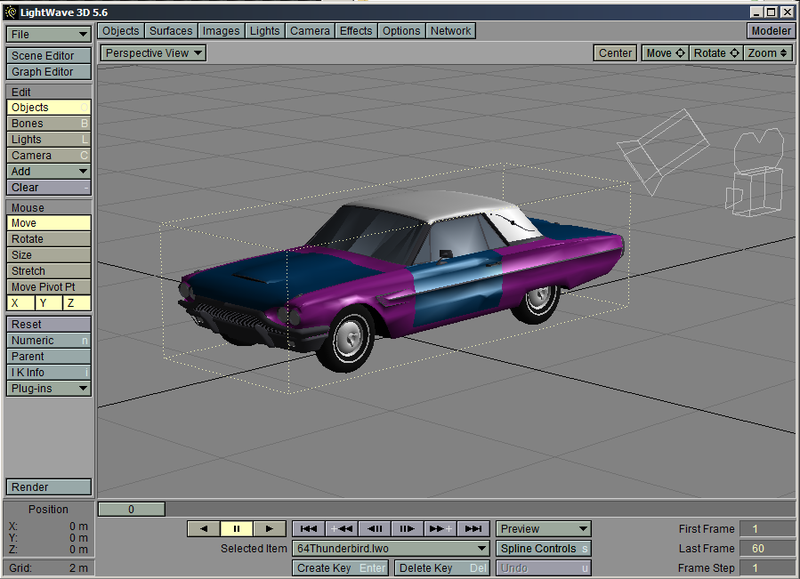
Modeler, Layout 5.6 Windows version
1997 - Inspire 3D 1.0
In 97, NewTek also released a cut-down version of LightWave called Inspire 3D for the PC. It offered the same ease-of-use as LightWave but was much simpler in terms of its abilities. Still, it brought many people into 3D who could then move up to Inspire's bigger and more powerful brother once they had a handle on what was needed.
- Screens courtesy: Ben Vost
- Box courtesy: Franck Lafage
- Logo courtesy: NewTek Europe
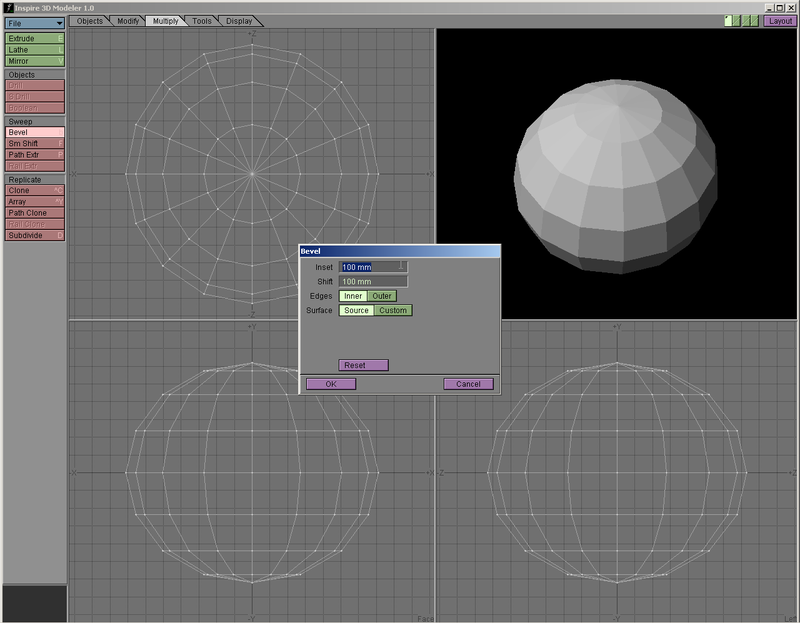
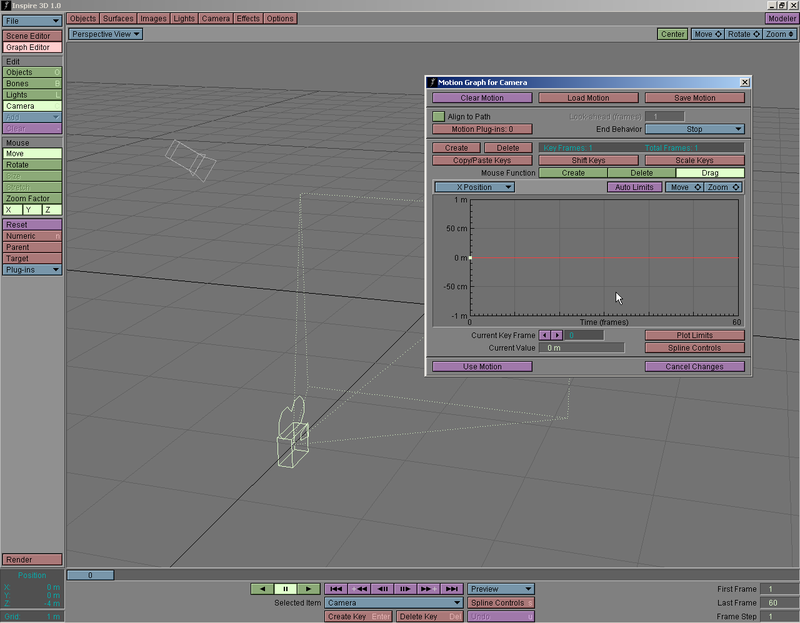
Inspire 3D Modeler and Layout, Windows version
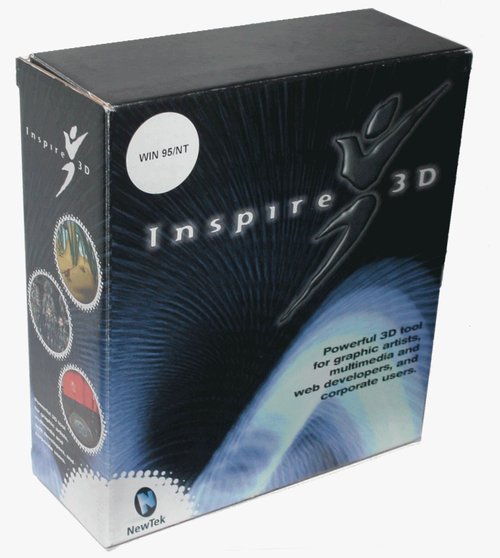
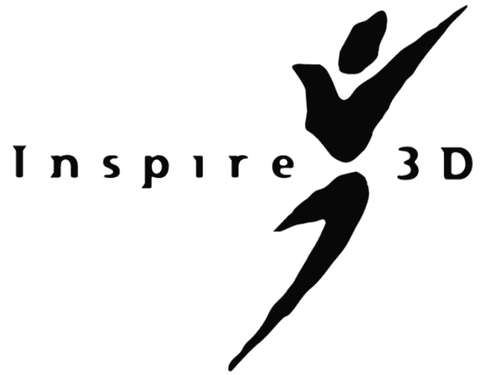
Boxshot and Logo
1999 - LightWave 3D 6
The redesign version! LightWave got a major redesign and a new element - the Hub - was introduced to synchronize files between Layout and Modeler automatically. There were numerous other changes, such as a new, user-editable menu system, the ability to have multiple layers in a single object along with the ability to keep them in sub-patch mode, rather than having to freeze when you saved out of Modeler.
LightWave 6 was the first commercial application to introduce HDRI, and the first incarnation of a new render engine at 192-bit. A first implementation of Monte Carlo and Interpolated radiosity for LightWave3D.
Modeler introduced many new tools like skelegons, and upgraded many modifiers to interactive tools.
- screens courtesy: Czech LightWave Users Homepage
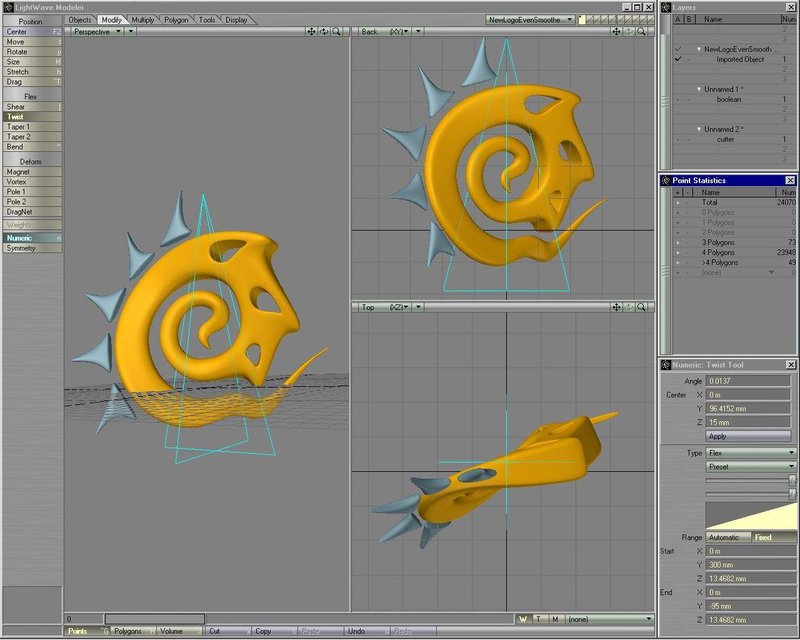
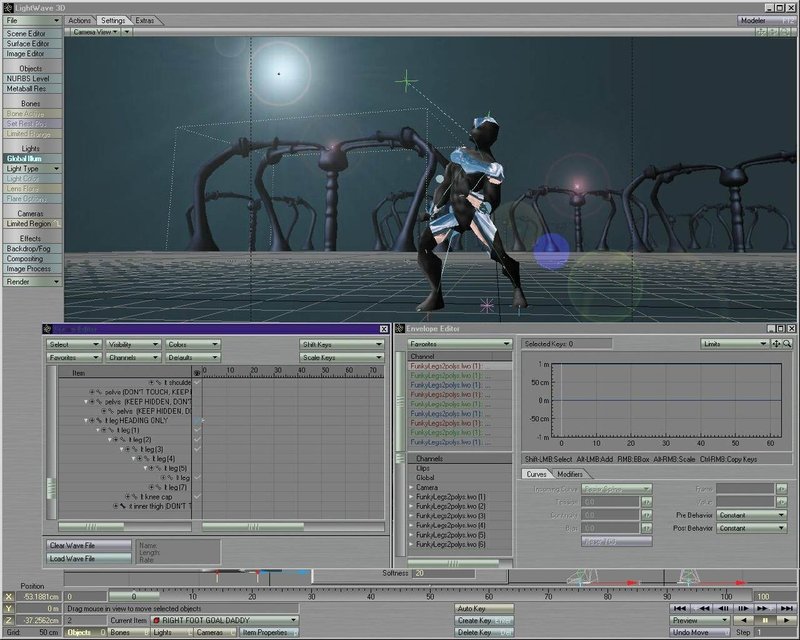
Modeler, Layout 6.0 Windows version
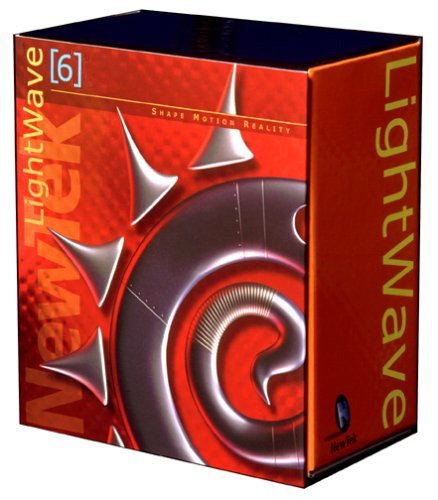
Boxshot
2000 - LightWave 3D 6.5
Because of the major redesign, more than a few people complained about the stability of LightWave in its new incarnation, but NewTek was on the case. A year after the release of 6.0, they brought out 6.5. It fixed most of the people's primary concerns, but also added cloth dynamics and Motion Designer 2 - in a free upgrade!
- screens courtesy: Dean Scott
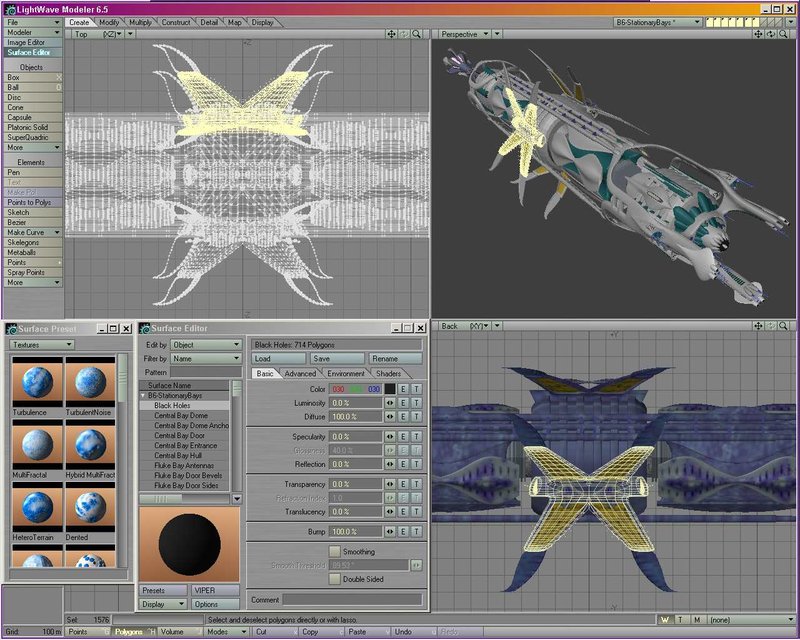
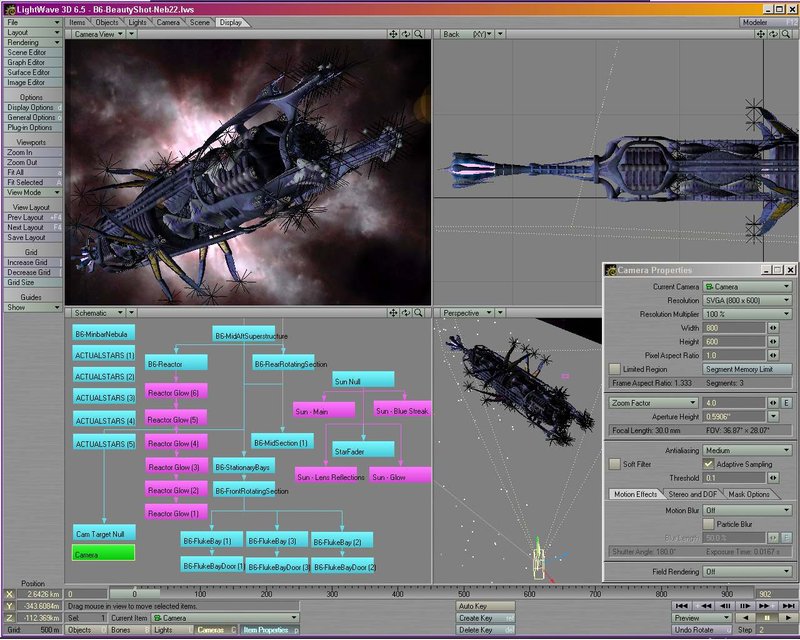
Modeler, Layout 6.5 Windows version
2001 - LightWave 3D 7
LightWave 7.0 added new radiosity methods and integrated new character animation tools: motion mixer for non-linear animation, new bone setup for faster preview, new subdivision options to speed up animation workflow. The SasLite hair and fur solution was added, along with many other additions.
- screens courtesy: Dean Scott
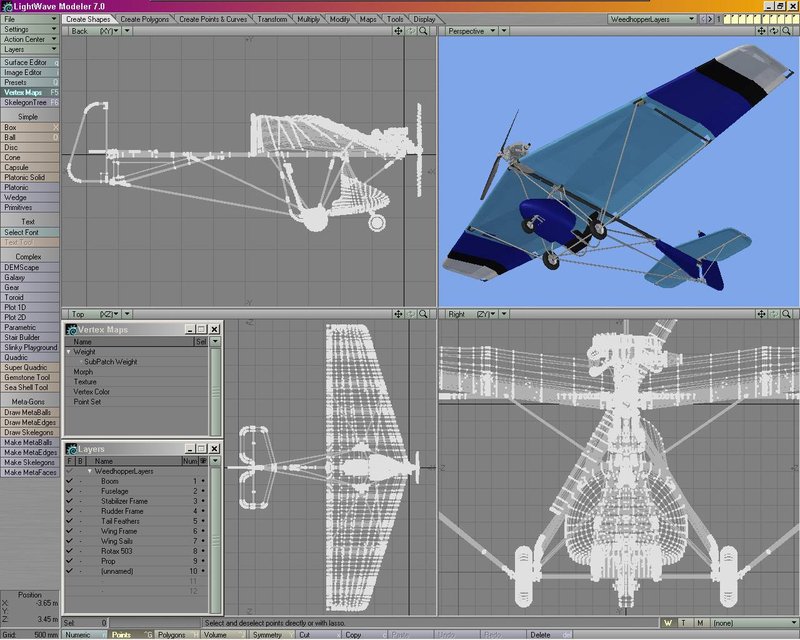
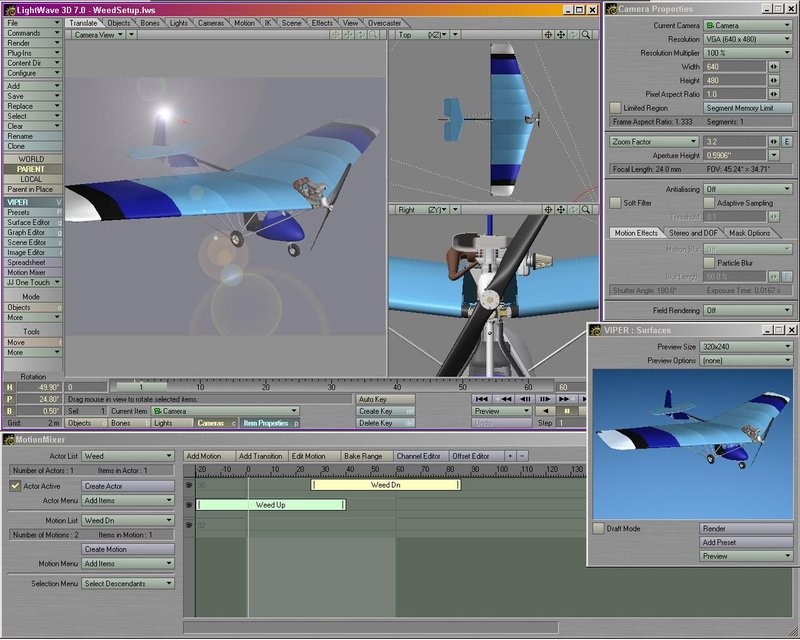
Modeler, Layout 7.0 Windows version

Boxshot and Logo (lores!)
2002 - LightWave 3D 7.5
Another free upgrade to LightWave including such features as improved radiosity and caustics, better OpenGL performance, BVH motion capture support, Powergons (polygons with scripts attached), Bandglue, and the well-named Magic Bevel among other things. 7.5 was eventually followed by 7.5b (06-Mar-03), which was not very successful and had a number of problems, and so was replaced almost immediately by 7.5c (16-May-03). This remained the cutting edge of LightWave for a time, but once LightWave 8 was released, a last update to 7.5 (7.5d on the 27-Aug-04) was released to counter problems with Apple's OpenGL implementation in OSX 10.3.
The 7.5b, c, and d revisions were the first visible fruits of the new development team's labors.
- screens courtesy: Ben Vost
- box courtesy: Darkside Animation
- logo courtesy: NewTek Europe
- Update PDF
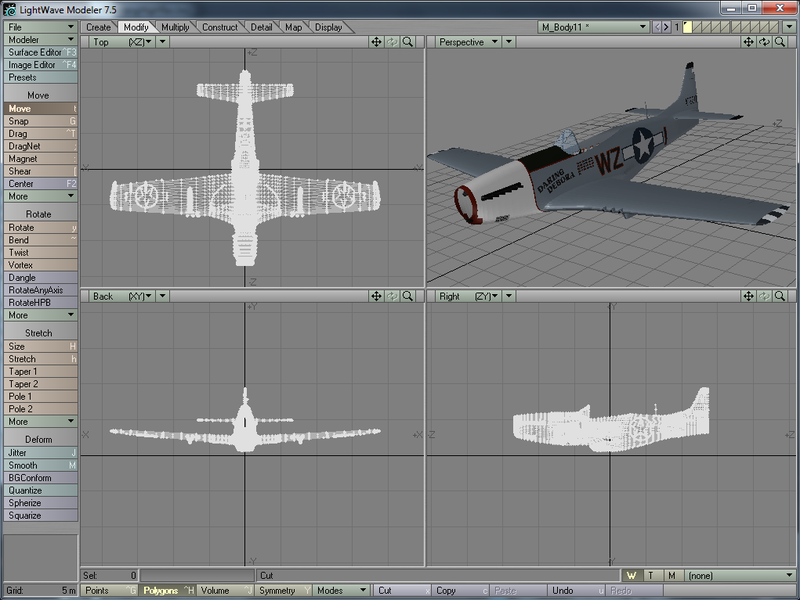
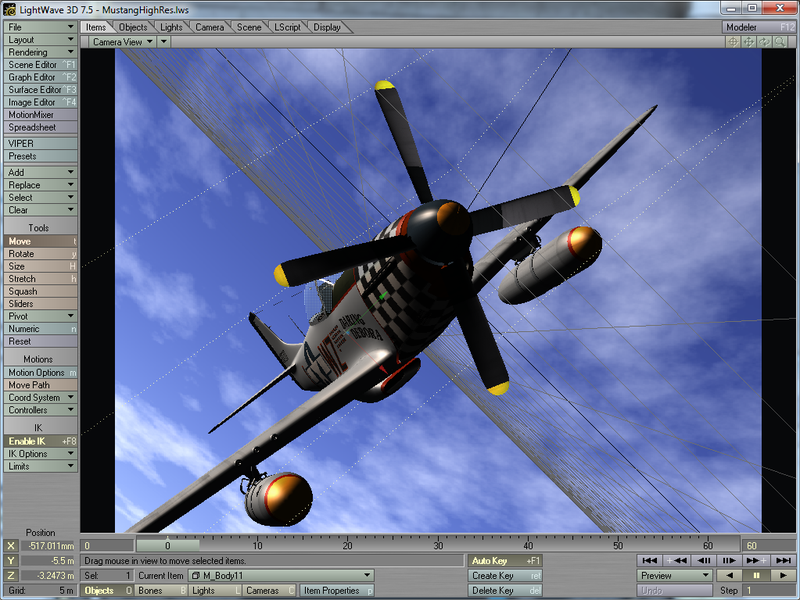
Modeler, Layout 7.5 Windows version
2004 - LightWave 3D 8
A long hiatus caused by the split between the original programmers and NewTek management meant that LightWave 8 had to be created by software archaeology - digging through the code in an attempt to understand it. This work paid off and resulted in the first new version in two years officially released on 30-Jun-04. For some people, LightWave 3D 8 was only a commercial plugins collection, but it was the real starting point of LightWave3D Reborn. The new team starts to integrate many of their external plugins and add powerful features like Bone Tools (a complete bone edit system), a new Scene Editor with Dopesheet (to edit keys in the timeline more comfortably) and the DopeTrack (for editing keys inline with the timeline), new rigid and soft dynamics, soft and hard links to animate the new dynamics, new OpenGL acceleration and preview, and many other small but important improvements.
- Screens courtesy: Ben Vost
- Box and logo courtesy: NewTek Europe
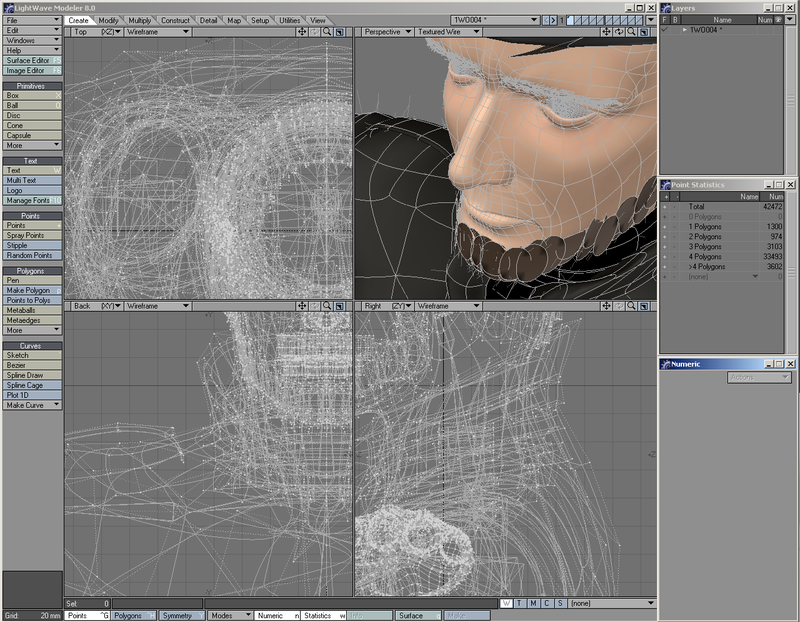
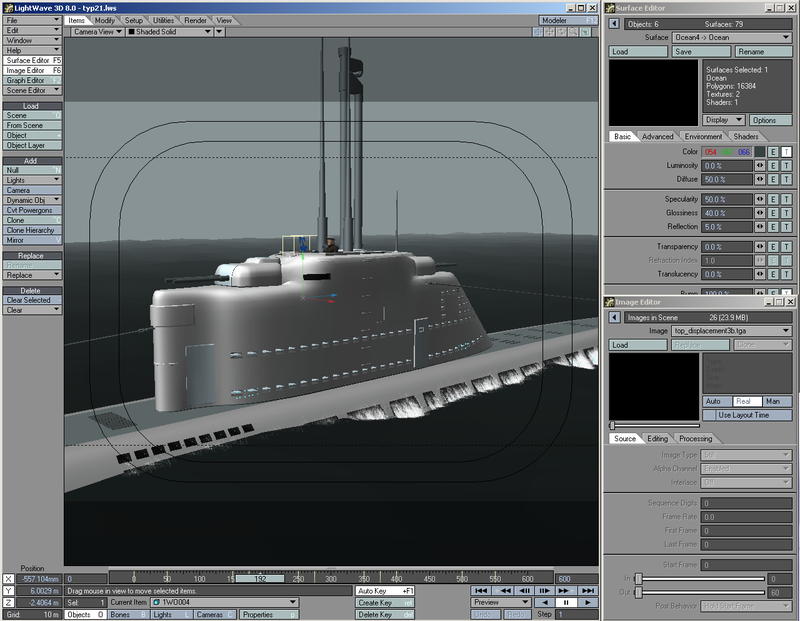
Modeler, Layout 8.0 Windows version
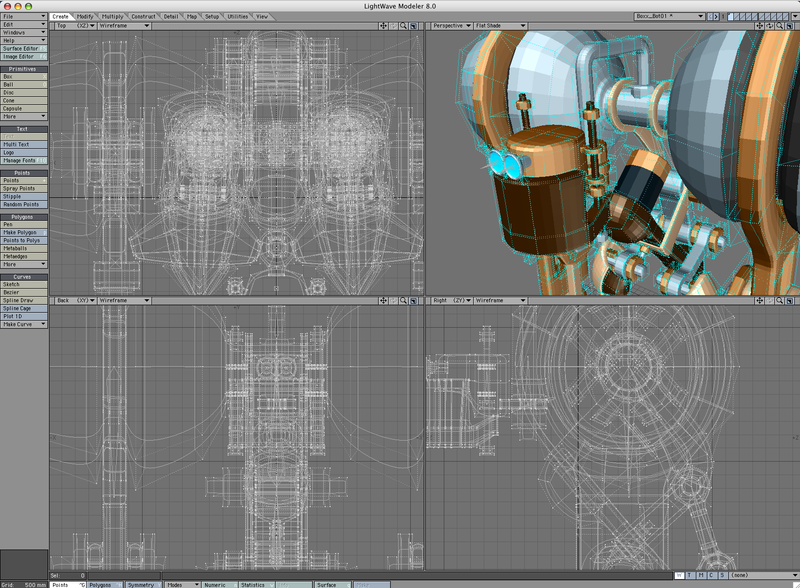
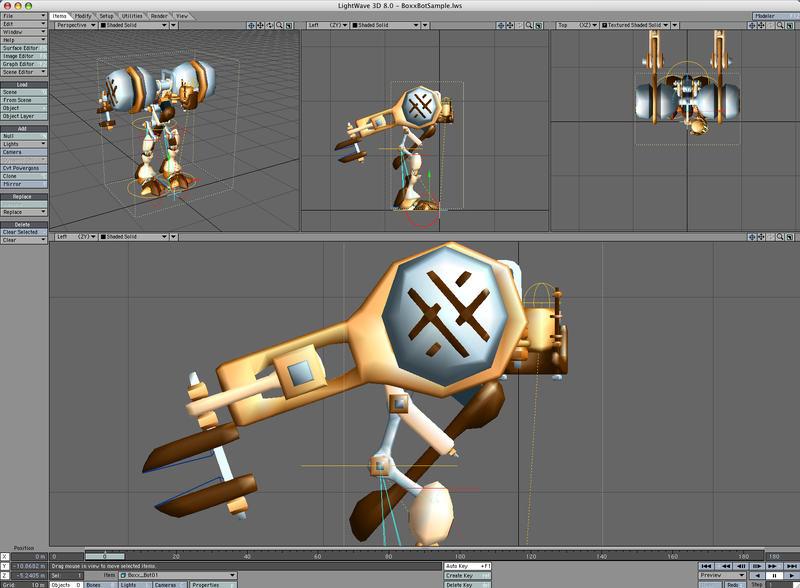
Modeler, Layout 8.0 OS X version
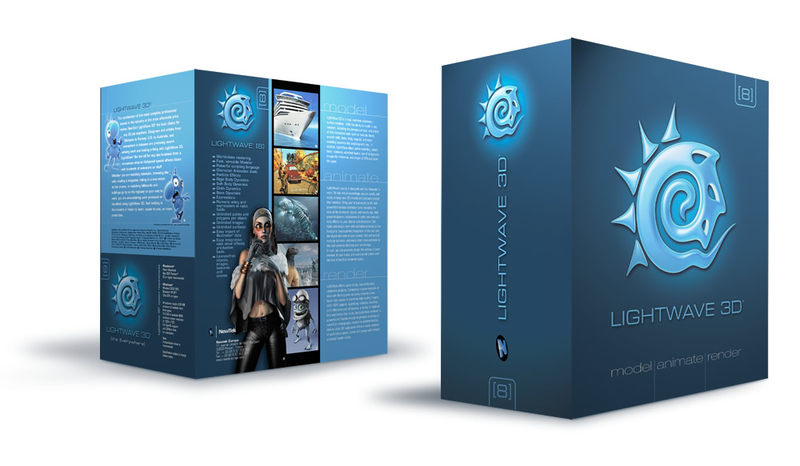
Boxshot
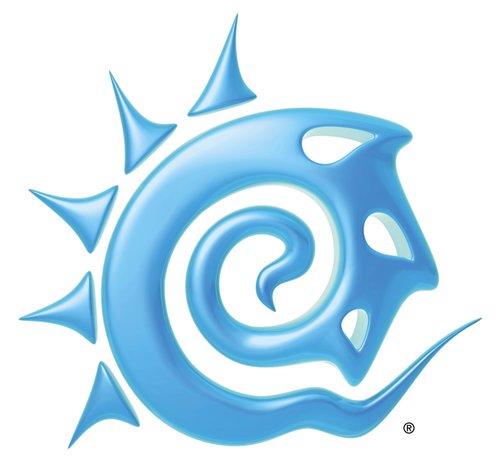
Logo
2004 - LightWave 3D 8.0.1
The first patch to LightWave 3D [8] released Sep-01-04.
2005 - LightWave 3D 8.2
Second free upgrade released Jan-18-05
This update included a method of making distortion-free UV maps for subdivision surfaces and was a world-first. Apart from bug fixes it also introduced PLD anti-aliasing, improvements to VIPER and IK Booster. Also included was a Linux version of Screamernet supplied as an RPM. This has not been updated since.
2005 - LightWave 3D 8.2.1
Patch for 8.2 released Mar-02-05
2005 - LightWave 3D 8.3
This was the fourth free update made available to registered users of LightWave 3D 8 on May-09-05. It offered improvements to HyperVoxels, Photoshop export and lots of other things...
- Screens courtesy: Ben Vost
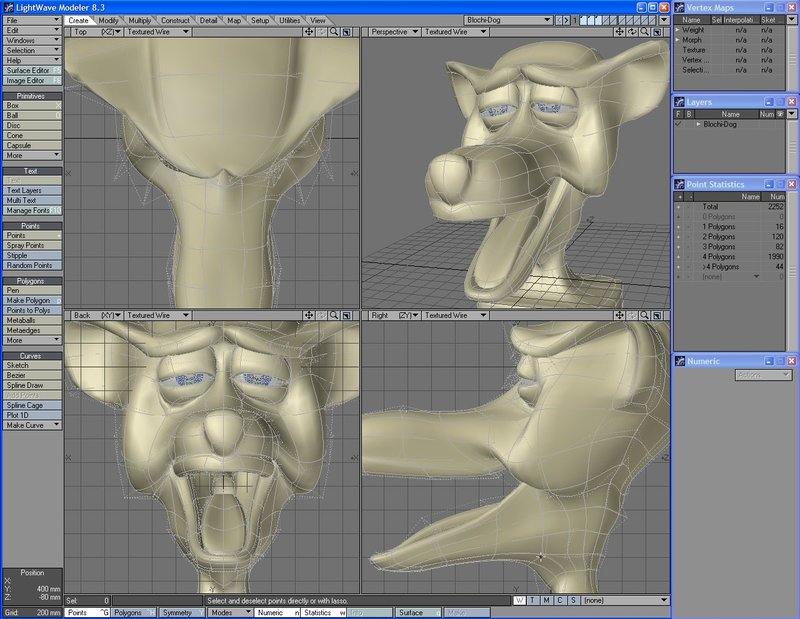
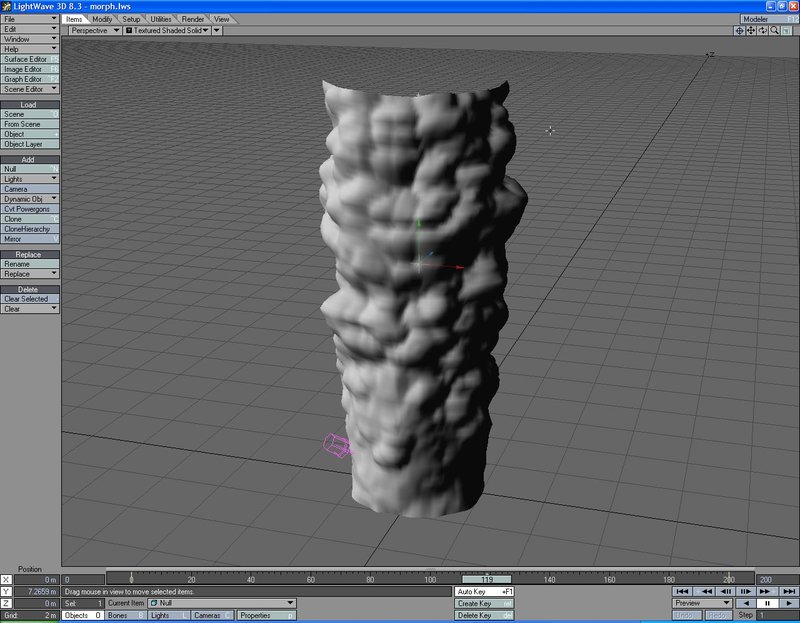
Modeler, Layout 8.3 Windows version
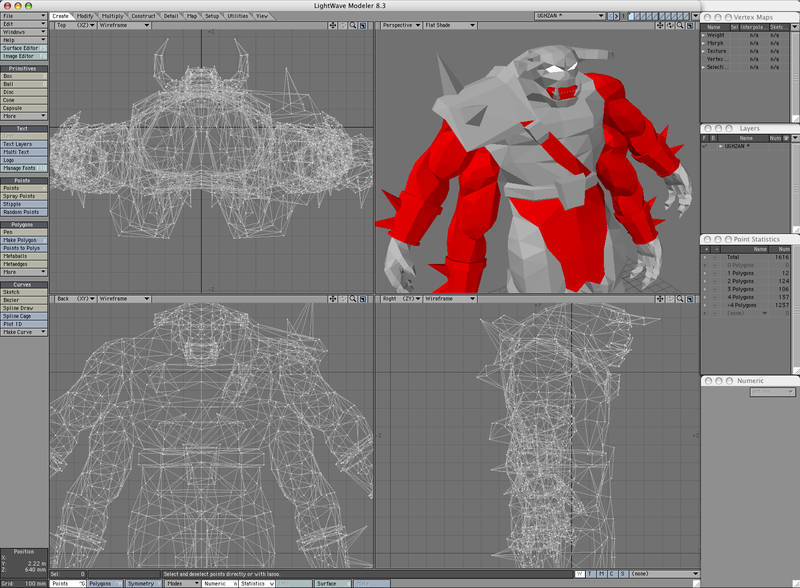
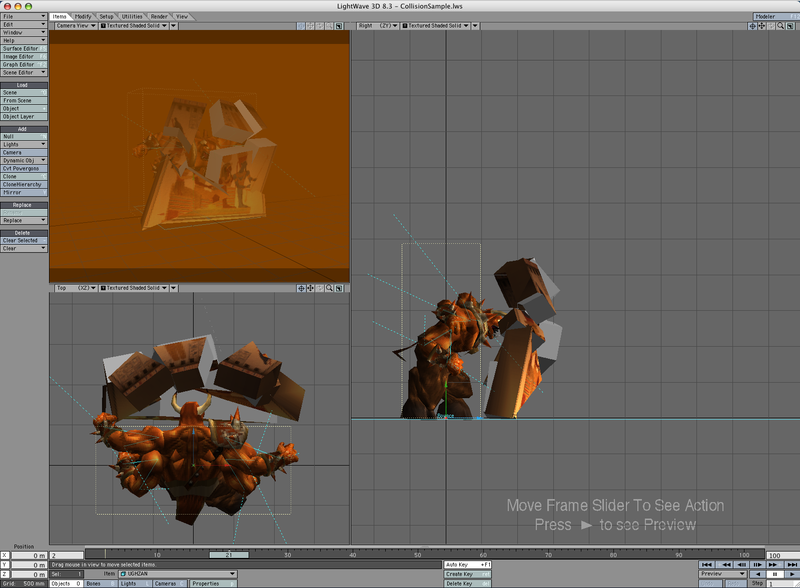
Modeler, Layout 8.3 OS X version
2005 - LightWave 3D 8.5
Fifth free upgrade released Oct-10-05
This new update adds GLSL compatibility to LightWave's Layout section and Multishift to its modeling tools along with plenty of bug fixes and implementations of feature requests.
On the 20-Oct-05, NewTek also released a 64-bit version for Windows XP Professional xp64 edition. This allows people with 64-bit Windows-based machines the chance to access more than 2GB ram. As of writing, this version does not exist for the Mac since OSX is not a completely 64-bit OS at time of writing.
2006 - LightWave 3D 9
Released Jul-13-06
- box and logo courtesy: NewTek
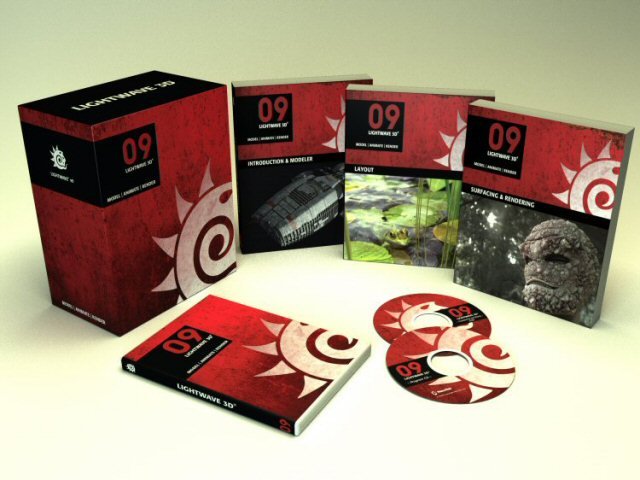
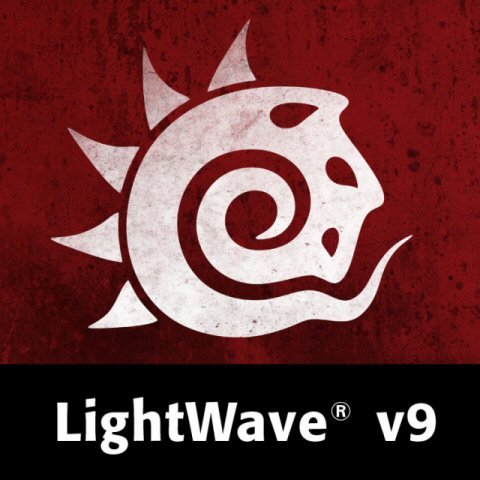
Boxshot and Logo
This is the second evolution (6.0 was the first overhaul) of LightWave and the feature list is very exciting! New features include:
- Node Editor for surfaces, displacements and volumetric lighting
- Realworld cameras
- Catmull-Clark subpatches
- Edges in Modeler
- Speed Boolean
2007 - LightWave 3D 9.2
Released Apr-25-07
- Improvements across the renderer and shading pipeline
- Three radiosity modes: Backdrop, MonteCarlo, Final Gather
- Interpolated radiosity switch for fast radiosity solutions for any of the three modes
- Photoreal motion blur and adjustable shutter efficiency to eliminate strobing
- Photoreal depth of field
- Physically correct materials
- Much-improved Modeler OpenGL
- Layout previewing of motion blur/depth of field
2007 - LightWave 3D 9.3
Released Aug-17-07
- Point/Edge Rendering in new cameras
- Single-sided area lights
- OpenEXR image loader/saver
- Volume stacking (means an end to using reversed geometry to indicate changes of IoR)
- New subsurface scattering nodes Fast Skin and Sigma 2
- Macintosh Universal version for improved Intel-based Mac rendering (roughly 3x faster on average)
2007 - LightWave 9.3.1
Released Nov-20-07
- A maintenance update that provides improved reliability and speed enhancements to the additions made in LightWave v9.3.
(note: the Windows installer contains both the 32-bit and 64-bit versions)
2008 - LightWave 9.5
Released Aug-12-08
- Enhanced radiosity with disk-based cache and unique animated radiosity caching mode.
- FiberFX hair and fur rendering system supports combing, dynamics, raytraced fibers, radiosity-shaded fibers and modeled fiber creation.
- Much improved IK/Rigging features, Same As Item controller, improved IK stability, Pole Vector, Align to XY Plane IK goal.
- Joint bone types, easier to rig, allow correct twist along their lengths and allow for stretchy limbs.
- HDR antialiasing options in the image viewer.
- Lights are now an API allowing for third party lights to be coded with the SDK. New light types included are Dome, IES/Photometric, and Spherical/Ball lights. Area lights quality improved.
- Collada, FBX added and OBJ I/O support improved.
- Interpolated Soft Reflections/Refractions for Node-based surfacing.
- Composition Overlays for composing shots.
- EXIF metadata support for images loaded and rendered.
This version was not available for Macintosh OS X, only Windows 32- and 64-bit.
2009 - LightWave 9.6
Released Jan-19-09
Layout 9.6 Windows version
- FiberFX Cloning - Provides the ability to place multiple instances of hair on the same object
- Layout Snapping - Allows the quick connection of one item to another, saving time and additional steps
- Ray Cutoff - Enables artists to decide at what point to stop further ray bounces when rendering a scene with many reflections, refractions, and transparency, saving significant project time
- New and Improved Buffers for Export - Enables multi-pass pipeline users to output more buffers (layers) in high dynamic range, rather than be limited to 8-bpc (bits per channel), for greater flexibility
- Multi-Threaded Pixel Filters - Provides faster rendering for projects that integrate pixel filters
- Depth Buffer Normalizing - Allows 3D scene elements exported into film or video footage to automatically blend properly, even if moving relative to one another
- Open to Other Render Engines - Other rendering engines conforming to the LightWave v9.6 SDK can be used directly from within the LightWave interface
- Three New Nodes
- Car Paint: Greatly eases the creation of a complex polished surface
- Flake: A procedural texture based upon the flakes often seen in car paint
- Curve: Allows the creation of complex gradients
- Drag and Drop - Allows an icon of an object or scene to be directly dropped into the Modeler or Layout window to load
2011 - LightWave 9.6.1
Released Jun-8-2011
The last release of LightWave 9 was publicly made available in June 2011 (although it had been available to open beta testers for a year before), long after the release of LightWave 10. It added a couple of bug fixes, but more importantly a 64-bit version for Mac owners.
2010 - LightWave CORE
Announced Feb-04-09, canceled Jun-23-11
CORE was announced to have a lot of innovative features:
- Complete rewrite, will not have all of LW9.6's features, will introduce new features replacing sets of LW9.6 features
- Internal application structure and SDK expose all features openly allowing easy future development
- Linux support. Equal support for Linux, Mac, and Windows
- Qt cross-platform GUI. Skinnable dynamically via CSS and viewport color configurations
- Complete loss of LW9 and earlier plug-in and scripting backward compatibility
- With Qt, have cross-platform plugins using the same source code. Easier Windows / Linux / Mac / 64-bit / 32-bit support, requiring only a recompile for that OS.
- Internal architecture's full exposure allows all subsystems to interact with each other, e.g. hair influenced by water simulation
- Partial LWS file compatibility specifically if the LWS uses plug-ins from LW9 and older
- SDK now a more vital component to LightWave as it's used by NewTek for actually building LightWave CORE. The previous SDK enabled 3rd party support only.
- Native Python scripting. LScript no longer supported. SWIG - allows many more language to be used to program to CORE SDK (Tcl, Perl, Guile, PHP, Java, Ruby, C#, LISP, OCaml, LUA, Modula-3, Javascript, R, Octave).
- New Collada-based file format superseding LWS and LWO
- Unified modeler and layout, if the user desires. Dockable UI, tear-off menus.
- Instancing
- History / modifier stack
- GPU awareness for on-GPU acceleration of subdivision calculation allowing radically larger numbers of OpenGL preview polygons faster
- Brush editing
- Lattice deformation
- "Construction" viewport plane
Even with these features, what was lost was a sense of LightWave about the program and with a change of management of the development team it was decided to use CORE as a testbed behind closed doors to bring these new technologies to LightWave as it was already known. This led to the release of LightWave 10.
2010 - LightWave 10
Released Dec-30-2010
Layout 10 OS X
LightWave 10 is the first new ordinal release of LightWave since 2006. It added three major new functionalities - Colorspace management, VPR and the Virtual Studio.
- Color space management - Because LightWave operates linearly concerning color whereas everyday colors displayed on a monitor are subject to the sRGB colorspace, meaning they have a Gamma of 2.2 applied, it always meant that lights had to be forced in the past, or colors tuned to match expectations. LightWave 10's colorspace management meant that it was simple to make LightWave behave in a color-managed way.
- VPR or Viewport Preview Renderer - In many LightWave users' opinions, Worley Labs FPrime was their main reason to use LightWave. Still, there were more and more things that FPrime couldn't show, particularly with nodes needing pre-processing, or the new radiosity schemes introduced in LightWave 9.3. LightWave 10 has introduced VPR that converts the OpenGL view normally found in a viewport to a realtime renderer.
- Virtual Studio - A system for realtime animation in the viewport using external controllers, eg. PlayStation Move cameras or the Microsoft Kinect, to move LightWave characters.
2011 - LightWave10.1
Released Jul-29-2011
Layout 10.1 OS X
2012 - LightWave 11
Released Feb-20-2012
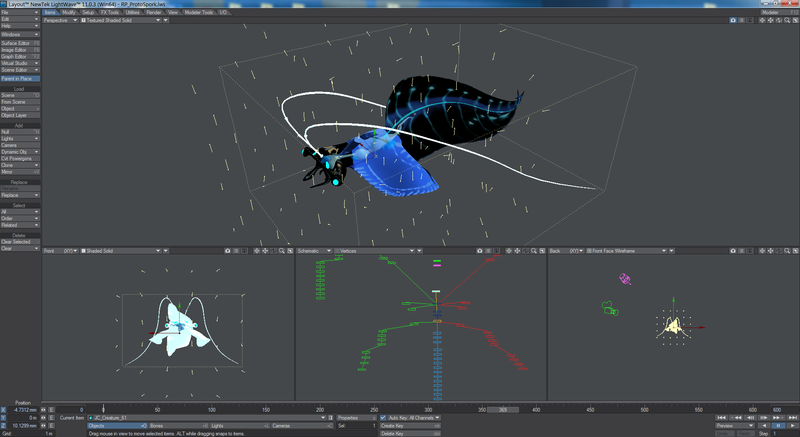
Layout 11.0.3 Windows
LightWave 11 adds a lot to LightWave, making it one of the most complete new ordinal versions ever. Here are some highlights:
- Instancing - Although instancing has been available to LightWave for a long time through commercial and free plugins, this is the first time that LightWave can generate billions of polys at render time itself. Instances can be seen in OpenGL and VPR.
- Flocking - Using the simple rules that govern flocking in nature, LightWave now creates huge flocks of "animals" (in conjunction with instancing).
- Unified Sampling - Previously in LightWave you have needed to tweak anything that uses sampling in all the places that do so. This also slowed down the render dramatically and now it has all been unified you get the concomitant speed-up in rendering as well as simpler use.
- Bullet Dynamics - World-class realtime hard-body dynamics are now in LightWave and are very easy to use - you only need tell LightWave that an object is dynamic for it to be.
- Fracture - An integral part of the dynamics system now is the ability to break stuff apart and you can now do so in Modeler and Layout.
- Virtual Studio Tools - Control Layout through 3D Connexion devices or even PlayStation Move controllers.
- Interchange Tools - Add seamless workflow between LightWave and ZBrush through GoZ or Unity.
- Shadow Catcher Node - A simple way to add an object to catch the shadows and reflections of your LightWave objects in a composite with real world elements.
- Python - The powerful scripting language has been added alongside LScript, but can directly access the SDK.
2012 - LightWave 11 SP1 (11.0.1)
Released Apr-16-12
A bug fix release with over 130 issues corrected or improved. The Unity workflow also got a significant boost with a new Applink package.
2012 - LightWave 11 SP2 (11.0.2)
Released Jul-09-12
A second bugfix release. It adds no new features but merely corrects problems in previous releases. 78 fixes have been tracked.
2012 - LightWave 11 SP3 (11.0.3)
Released Aug-01-12
A third service pack release. The sole feature in here is a new licensing system that allows for a software license rather than using the hardware dongle that LightWave has been tied to since it was first split from the Video Toaster.
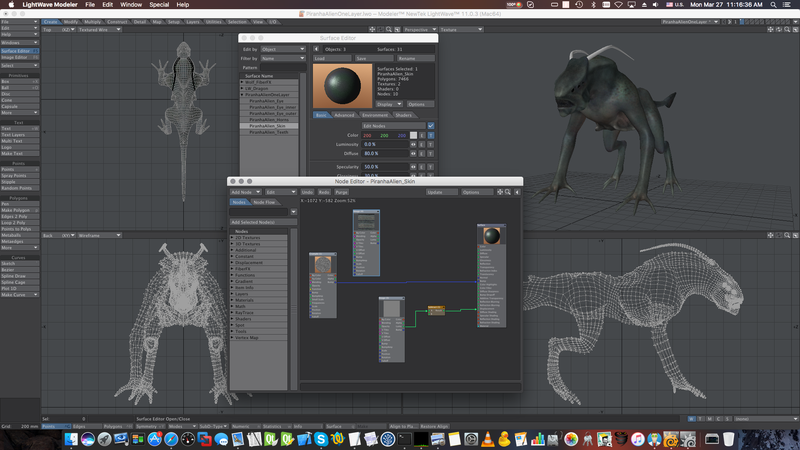
Modeler 11.0.3 OS X
2013 - LightWave 11.5
Released Jan-31-2013
A massive free update that includes the following and more:
- Flocking - Nodal flocking - Predator/Prey behavior - Attract/Avoid meshes
- Bullet Dynamics - Deforming bodies and Forces
- Interchange After Effects interchange
- FiberFX - New UI - Bundles and Braids
- Genoma - Full rigging system
- Modeler - Line Pen - Heat Shrink - Axis Translate/Rotate/Scale - Transform - Chamfer - Place Mesh - Slice - Thicken - Straighten - Edit Edges - ABF Unwrap UVs - Select by Normal - Pick Surface - New Paste Behaviour
- Workflow Enhancements - Node Editor Probe - Curved node Connectors - Dome Light with Image - MDD Multi-Loader - DoF, Motion Blur and Refraction in VPR - Advanced Camera support in VPR - Rolling Shutter - Motion Path Frame display - Nodal Metalink - Fit Selected and Fit All
- Python - New Plugin architectures - Single Shot format
2013 - LightWave 11.6
Pre-Released July-23-2013
At SIGGRAPH in Anaheim, CA this year the LightWave Group pre-released LightWave 11.6 along with a plugin called NevronMotion for retargeting motion capture files and ChronoSculpt, a separate program for adjusting MDD, Geometry Cache or Alembic files. More details will follow on here once all three are fully released.
Released 31-Oct-2013 LightWave 11.6, ChronoSculpt and NevronMotion are released.
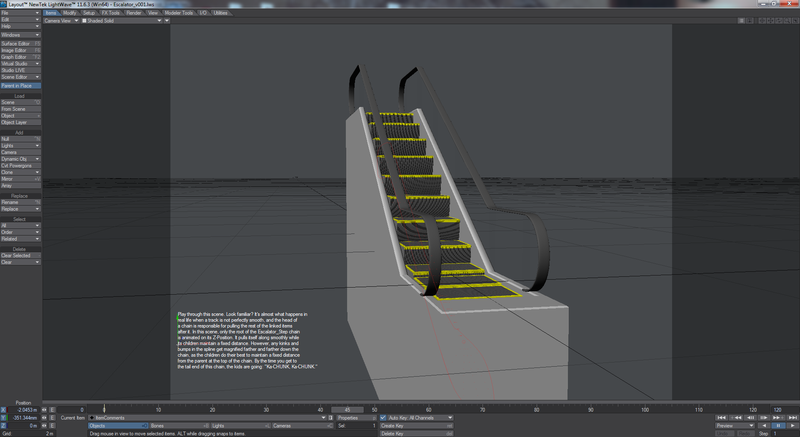
Layout 11.6 showing Spline Control
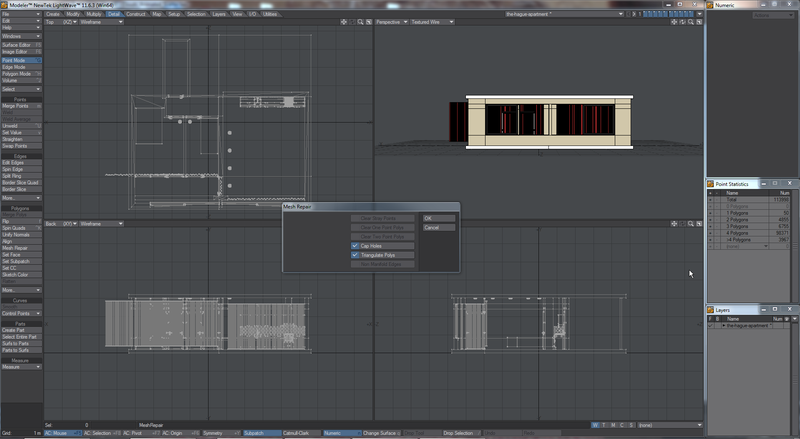
Modeler 11.6 showing Mesh Repair
Features new to 11.6 include:
- 3D Display - Displays VPR or OpenGL in stereoscopic 3D on a suitably-equipped TV or monitor
- 3D Printing - New tools and loaders/savers to help with 3D printing. LightWave can now load and save STL, PLY and VRML format models, and there is a tool that checks the mesh is good to print (no single point or two points polys, etc.)
- Alembic - Support for the open scene format
- Assignments - A set of scripts to help with hierarchical operations in Layout (parenting, targeting, etc.)
- CgFX shaders - Game engine shaders for display in OpenGL
- Color Picker - Because Ken Nign now works for the LightWave Group he has brought his excellent Jovian color picker plugin into LightWave as its main picker
- Compound Nodes - Node container to simplify networks
- DPX (Digital Picture Exchange) Image Loader/Saver - Image loader/saver for a digital intermediate format used a lot in production
- Genoma Spline Control - New subrig parts to add Spline Control features to rigging
- Input Node - New permanent node (like the Surface node) that contains many things that might be needed. A necessary addition needed for Compound nodes to work
- Light Falloff clamping - Now lights can have their falloff clamped to prevent overly bright areas inside the falloff zone
- LUT Expansion - support for more color lookup tables (LUT)
- Matching Perspective to Camera or Light - you can now size up a viewpoint in the Perspective viewpoint and copy it to the camera, or add a new camera. The same applies to matching the Light View with an existing or new light
- Python Reduced Instruction Set module (PRIS) - PRIS is designed to make coding scripts for LightWave more like LScript, rather than C
- Raycast Node - A node to allow you to sit something on a horizontal surface automatically, rather than needing to do it manually. Particularly useful if the surface is irregular and animation needs to take place on it
- Spline Control - A new system using nulls, bones or other items to create a spline that can be animated itself, but also serve as a path to animate other things along
2014 - LightWave 11.6.3
Released May-01-2014
Bug fix release (licensing problems resolved)
2014 - LightWave 2015
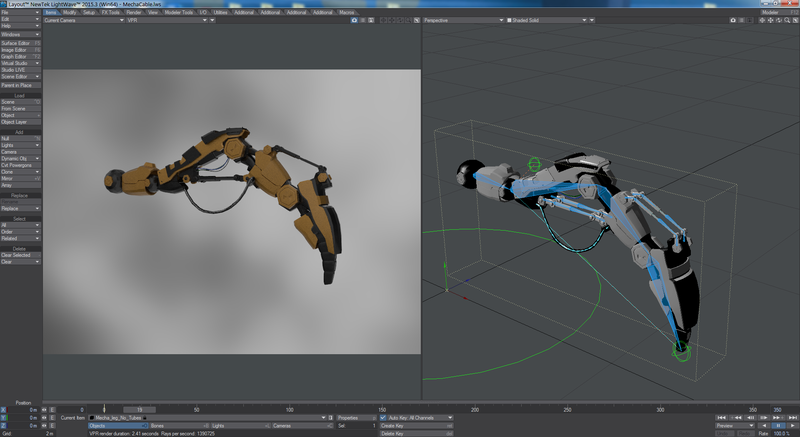
2015.3 Layout showing dynamics and bones
Released Nov-24-2014
LightWave dropped the version number in favor of annual numbering. This new version features:
- VPR in multiple viewports;
- Background Importance Sampling for quicker noise-free radiosity renders;
- Bullet Constraints;
- Better I/O with FBX, Alembic and point cache file improvements;
- Genoma 2 is an advanced rigging tool that is considerably more powerful than the original Genoma built into 11.5;
- Clip mapping is, at last, a surface property;
- Perspective Matching for still background images to better put 3D into them;
- Quicktime is supported in 64-bit versions of Windows
- any font supported by your OS can be used in Modeler
- dozens of workflow improvements
2014 - LightWave 2015.1
Released Dec-22-2014
Update 1 brings stability and bug fixes
2015 - LightWave 2015.2
Released Feb-23-2015
Update 2 brings stability, bug fixes and also these additions:
- OSX Support Full-screen mode for Layout and Modeler
- Re-purposed "Enter License" tool
- Small update to Transform Gizmo's rotate handle colors to match the color of the axis around which the rotation takes place.
- Support import of Mixamo rigs (https://www.mixamo.com/)
- Added 'Invert Color' option to the Image Node.
- Add User Preference For Double-Click deselecting in Modeler
- Made the NEW COMMAND "Drop/Restore selection" the default over Drop Selection in the menus and key configurations.
2015 - LightWave 2015.3
Released Aug-15-2015
- Several consolidations of functionality
- Improvements to stability
2018 - LightWave 2018
Released January-01-2018
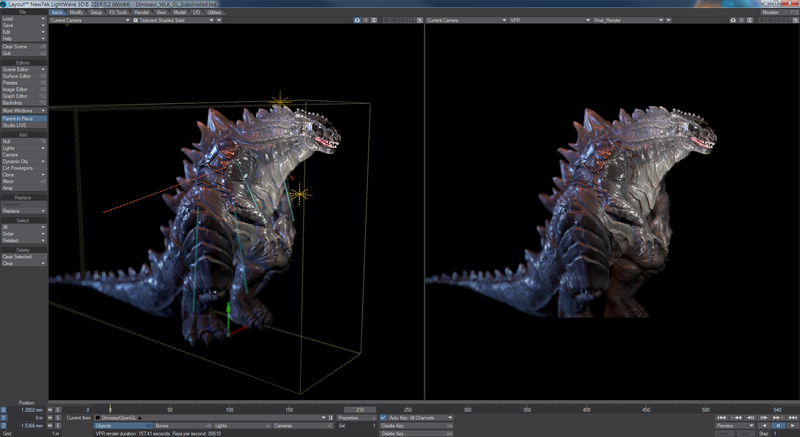
Layout OpenGL and VPR side-by-side
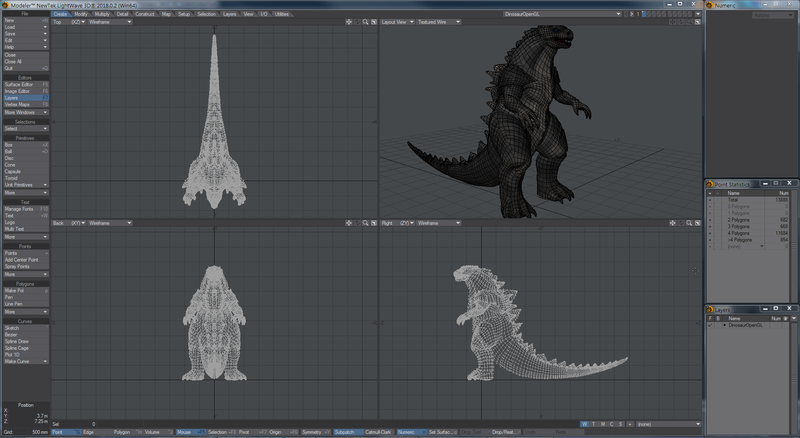
Modeler showing Layout View
- Physically Based Rendering System
- Render and Light Buffers
- New Volumetric Engine
- OpenVDB Support
- New Lighting Architecture
- Virtual Reality Camera
- Layout Modifier Stack
- New Cel Shader
- Layout Parametric Shapes
- Noise Reduction Filter
- UDIM Support
- Preset Shelf Improvements
- New Network Rendering System
- Online wiki-based Documentation
2018 - LightWave 2018.0.1
Released January-12-2018
71 bugfixes and feature requests implemented
2018 - LightWave 2018.0.2
Released March-01-2018
Over 200 bugfixes and feature requests implemented
2018 - LightWave 2018.0.3
Released March-29-2018
63 bugfixes and feature requests implemented
2018 - LightWave 2018.0.4
Released May-01-2018
29 bugfixes and feature requests implemented
2018 - LightWave 2018.0.5
Released July-02-2018
21 bugfixes and feature requests implemented
2018 - LightWave 2018.0.6
Released Aug-03-2018
Six bugfixes and feature requests implemented
2018 - LightWave 2018.0.7
Released Oct-31-2018
5 bugfixes and feature requests implemented
2019 - LightWave 2019
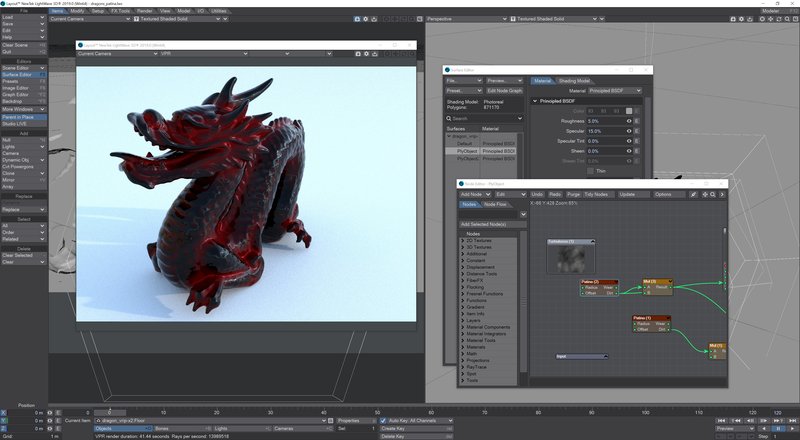
HiDPI interface
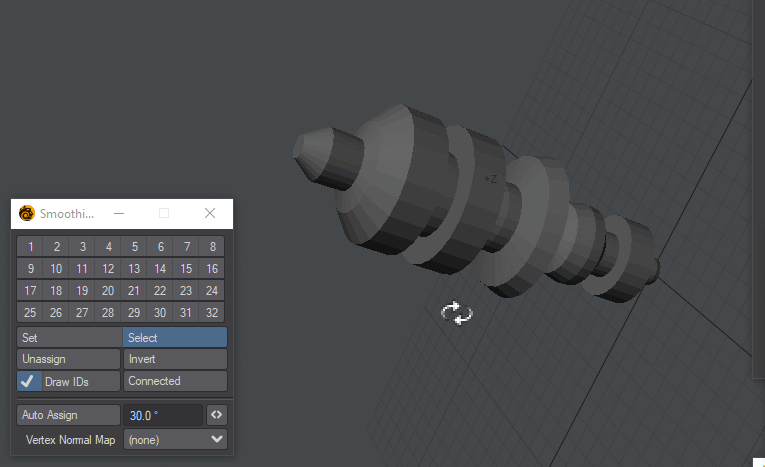
Smoothing Groups
Released Jan-22-2019
- Unreal Bridge - Dynamic interchange between LightWave and the Unreal Engine
- MetaMorphic - Animated sculpting plugin for Layout
- OpenVDB Conversion - Live editing of VDB <> mesh conversion
- Undo - Improved system-wide undo support
- Image Caching - Massively reduces memory use for images in-scene at render time
- Material Components - Pull apart materials to create your own look
- Edge and Patina Shaders - Creative shaders for more realism
- Smoothing Groups - Industry-standard smoothing is added to LightWave
- UV Tools - Updated UV tools
- SunSky - new backdrop shader and light type for simulating realistic and fantastic skies
- HiDPI Support - Adaptive UI layout for new monitor resolutions
- Menu Improvements - Searching, mousewheel and keyboard navigation dramatically increase workflow speed
- Updated documentation - Responsive wiki should now display correctly on all supports
2019 - LightWave 2019.0.1
Released January-31-2019
20 bugfixes and feature requests implemented
2019 - LightWave 2019.0.2
Released February-28-2019
54 bugfixes and feature requests implemented
2019 - LightWave 2019.0.3
Released March-13-2019
23 bugfixes and feature requests implemented
2019 - LightWave 2019.1
Released July-15-2019
New features
- Cel Shading now responds to scene light color
- FBX Improvements
- Hide all OpenGL non-renderable elements and gizmos
- Workflow improvements to the Layers panel in Modeler
- New Navigation options
- Node Editor - RGBA/XYZ splitter node/improvements
- NRC Improvements
- OpenVDB Improvements
- Physical Sky Enhancements
- Add Progress indicator to VPR
- LightWave Python Updates
- Workflow Improvements: 'Reset Configs'
- Workflow Improvements: Separate Menu and Key Config Files
- Workflow Improvements: Tree Pane
- Unreal Bridge Improvements
- Vertex Maps panel improvements
An incredible 282 bugfixes and feature requests implemented
2019 - LightWave 2019.1.1
Released August-05-2019
12 bugfixes and feature requests implemented
2019 - LightWave 2019.1.2
Released August-07-2019
3 bugfixes and feature requests implemented
2019 - LightWave 2019.1.3
Released September-12-2019
8 bugfixes and feature requests implemented
2019 - LightWave 2019.1.4
Released September-25-2019
7 bugfixes and feature requests implemented
2019 - LightWave 2019.1.5
Released January-15-2020
3 bugfixes and feature requests implemented
2020 - LightWave 2020
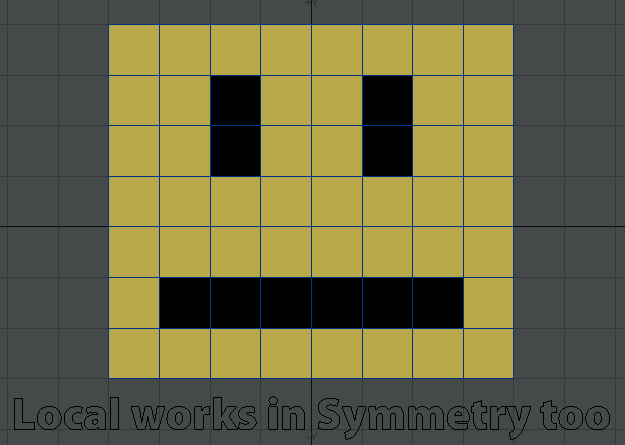
Local Action Centers with Symmetry
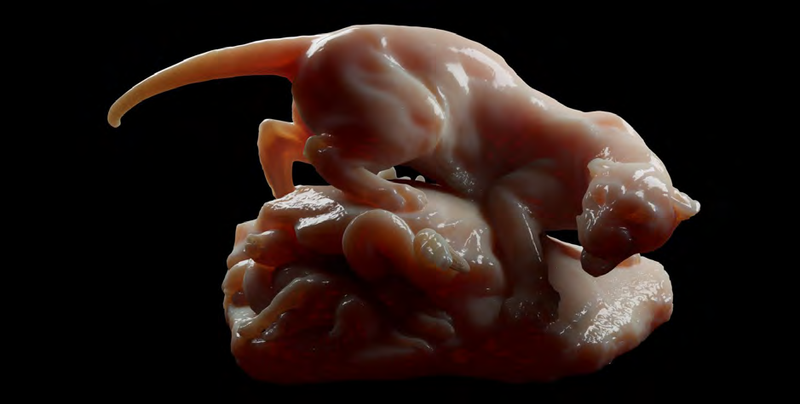
Random walk multi-spectrum subsurface scattering
Released April-23-2020
- Environment Lights - New streamlined workflow for setting scenes up
- New GI - Brute Force has been revamped, Irradiance Cache has been added, and a new Grid Bake solution has been implemented
- FBX interchange - Updates to LightWave FBX imports and exports for improved interchange
- OpenVDB - New tools for creating exciting new VDB-based animations
- OpenGL - New shaders mean that LightWave's OpenGL is an ever closer match to a rendered image
- Local AC - Modeler gains a Local action center
- Motion System Order - You can now set an arbitrary rotation order
- Simple Tone Mapping - Tone mapping for F9 and VPR renders gives control over the look of your render without needing to use a compositing package
- Improved SSS - Random walk multi-spectrum subsurface scattering has been added to the Principled BDSF material
- Better Hair and Fur - Two new materials have been added for hair and fur
- Scene Editor - New tools make the Scene Editor even more useful
- Node Editor - The middle mouse button can now be used to scroll around the Node Editor
- Instancing - More control is now given for the placement of individual instances
- Mobile NRC Monitoring - Android and iPhone applications for keeping track of your renders when you're out of the office
2020 - LightWave 2020.0.1
Released May-26-2020
More than 570 bugfixes and feature requests implemented
2020 - LightWave 2020.0.2
Released July-15-2020
More than 59 bugfixes and feature requests implemented
2020 - LightWave 2020.0.3
Released August-01-2020
Final bug fix release from NewTek
2023 - LightWave 2023
Images courtesy: Ben Vost
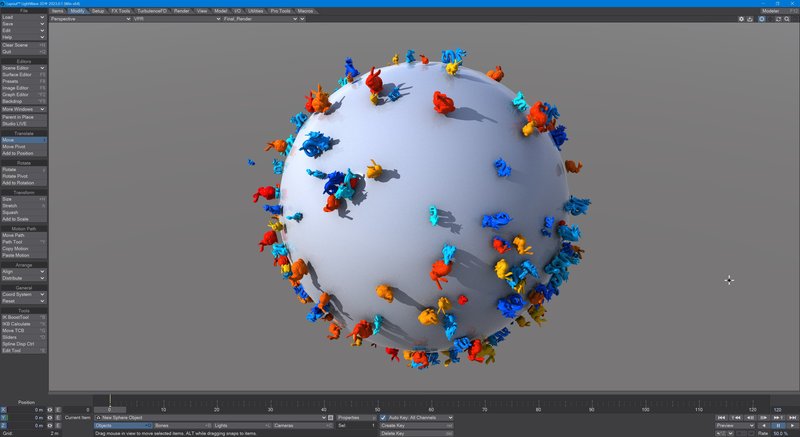
Instance Brush gives users the power to paint with instances, here roughly 200 million polygons
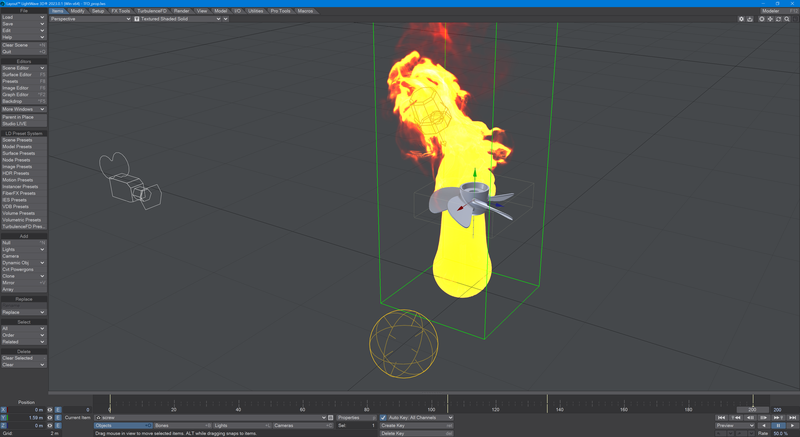
Turbulence FD provides realistic fire and smoke effects
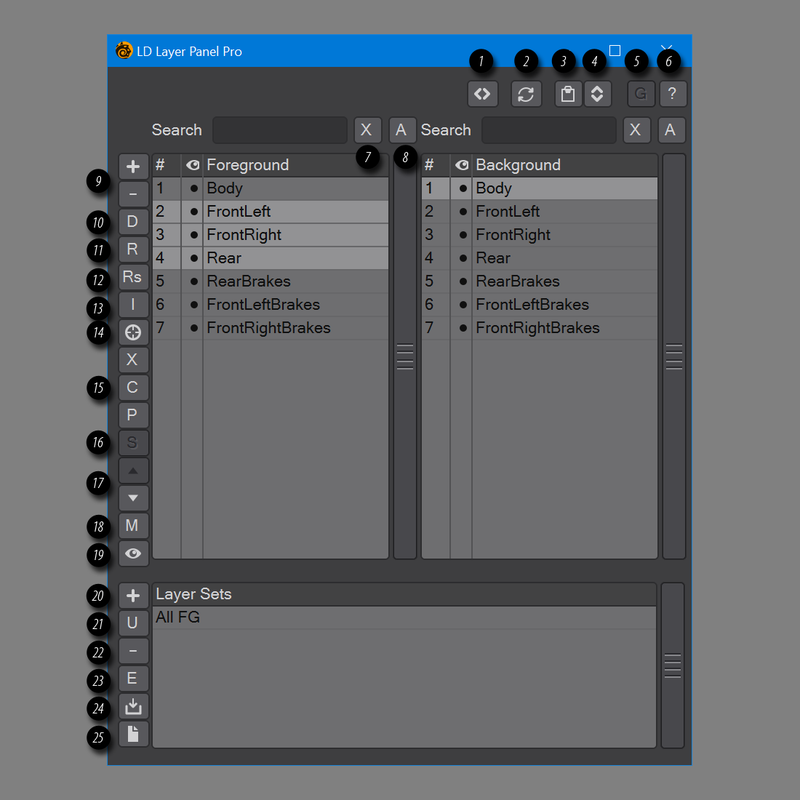
Layer Panel Pro is one of more than 400 scripts designed to speed workflow
Released November-28-2023
Rebirth of LightWave under a new company - LightWave Digital. This version was put together less than six months after the formation of the new company. Features include:
- Procedural Geometry nodes
- Instancer Brush - for painting instances on a surface, rather than just relying on Uniform or Random placement
- LightWave Pro Tools - a collection of more than 400 useful Python scripts covering areas from rigging vehicles to adjusting UDIM tiles.
- Octane Render - previously a commercial plugin, now LightWave includes a single-GPU licence of the powerful GPU render engine.
- TurbulenceFD - Incorporation of the Turbulence fluid dynamics engine. This uses LightWave's legacy volumetrics in this initial release
- Text Generator - live Layout-based font generation
- This initial release is Windows-only.
2024 LightWave 2023.0.1
Released February-09-2024
First release for Intel and Apple Silicon MacOS. Python for LightWave is still at version 2, so the Rosetta version must be used for any Python-based plugins. Several bugs are also corrected. There is no PC version of this release.
Unreal Bridge patch
Released February-29-2024
The real-time bridge for Unreal was put into people's accounts as a zip. It goes in the Unreal folder to enable Unreal to communicate with LightWave. Support for keyframe animation, (some) materials, instancing and more are included.
About this history
Copyright 2002, Dean A. Scott, chrusion | FX, all rights reserved. Updated version and editing by Ben Vost, NewTek 2005-2020, LightWave Digital 2023-present
